Note: MOTHER 2 will referred to throughout as EarthBound—just because I've played through the second game in the MOTHER trilogy almost a dozen times, and its title screen always said EarthBound.
Gosh. It's been a while, hasn't it?
I'll have you know I started working on a
MOTHER 3 writeup a few months after we finished our review of
EarthBound, but then some stuff came up and the enterprise found itself adrift in an authorial sargasso for the better part of two years. As far as I'm concerned, this puts us on excellent footing for the occasion. After all,
MOTHER 3, didn't materialize for more than full decade after the release of
EarthBound, and for years fans had every reason to believe the series would conclude with
EarthBound's "The End...?"

The
MOTHER 3 developmental timeline is a little murky: videogame news and previews were still confined to magazines through much of the late 1990s, so the armchair historian without access to a physical archive of
Nintendo Power, Electronic Gaming Monthly, and
GamePro issues from the period has to rely on the disparate magazine scans floating around the internet.
The records show that
MOTHER 3 was officially announced in 1996 at Nintendo's Spaceworld expo in Japan, but it wasn't until 1997 that North American fans found out it was coming as
EarthBound 64. I was in middle school then, and one morning the Mario-obsessed kid sitting two desks ahead of me in homeroom brought an issue of
Nintendo Power containing the first screenshots of
EarthBound 64.
Some
Nintendo Power scans give us a look at Nintendo's early plans for the title. Like
Super Mario Bros. had done,
EarthBound was taking the leap from 2D sprites and tilesets to a 3D engine. Moreover, it was being developed for the 64DD, a CD-ROM peripheral for the N64 scheduled to hit the Japanese market in late 1997. Nintendo suggested the game would follow on the heels of
Zelda 64 (later retitled
The Legend of Zelda: The Ocarina of Time), and projected a North American release sometime during 1998.
I can somewhat recall the discussions on the sections of the old
Nintendo Power message boards haunted by
EarthBound fans. (This was before
Starmen.net, you see.) We puzzled over the screenshots and devised elaborate theories based on the scraps of information we'd been given. So what did it all
mean, we asked. Was the main character supposed to be a cowboy now? What happened to Ness? How fared Eagleland? What were we supposed to make of that pile of
wreckage with the Onett billboard? Where was the game actually set? The old west? Some bizarre future? A fantasy world completely removed from
EarthBound?? And what about Pokey? What the hell happened to Pokey?

We waited for more news. And we waited. And we waited.
The 64DD kept getting delayed, and so did
EarthBound 64. Every so often
Nintendo Power or some other magazine would publish a blurb reminding us it was still on the way, but substantive new information remained scant. At some point in 1998, when it became obvious to everyone that the N64DD was a wind egg,
Nintendo announced that
EarthBound 64 was still on its way, but was being reformatted as a standard N64 cartridge game. At some point, the phrase "Fall of the Pig King" was added to its title. It disappeared from
Nintendo Power's Release Forecast page, and then reappeared. A playable demo was presented at Spaceworld in 1999.
And then in August of 2000, the news broke:
EarthBound 64 had been aborted. It was left to the unaffiliated gaming journalists to break
the news;
Nintendo Power never published an obituary.
EarthBound fans went through the customary rites of mourning. We signed petitions. We replayed
EarthBound and the "
EarthBound Zero" NES ROM. We mained Ness in
Super Smash Bros. We wrote fanfiction and drew comics for Starmen.net. We regressed from speculating about
EarthBound 64 back to pondering all of
EarthBound's imponderable mysteries and wondering if any of them would have been resolved by
EarthBound 64.

In 2002, we fans up at the news of a
MOTHER 1+2 compilation under development for the Gameboy Advance, which was
something, but only slightly better than nothing. (Even before game companies were habitually repackaging and reselling old classics on new systems, some of us were already sensing that being able to buy and play
Chrono Trigger on six different consoles/mobile devices wouldn't be quite the same as getting a new
Chrono game, and shouldn't be taken as an indication that one was on its way.) Some versions of the Japanese TV commericials claimed that the third game was still forthcoming as a GBA title. Itoi verified this in April 2003, but the project once again seemed to be in abeyance: for years there were no official annoucements, no release dates, no screenshots, nothing but hints and rumors.
2005 saw the first of two
MOTHER-related miracles. Eleven years after
MOTHER 2, nine years after the announcement of
EarthBound 64 and five after its cancellation, and three years after
MOTHER 1+2 teased it,
MOTHER 3 for the GBA was officially announced by Nintendo and slated for a spring 2006 release.
EarthBound 64 was being rebuilt almost from scratch, by
Legend of Mana developers Brownie Brown instead of APE. Much of
EarthBound 64's setting, cast, and scenario were carried over, but this was still like taking the script of a cancelled film, rewriting it, recasting all the actors and crew members, building completely new sets, and shooting every scene over again. How often do you see this kind of thing happen in
any medium? What else can you call it but miraculous?

The
first batch of screenshots were presented in February 2006, and they were beautiful. Sometimes you'll look at the preview materials for the sequel to one of your favorite games and be unpleasantly piqued by how
different it looks from the original, and can't help worrying it will be too dissociated from its antecedent to measure up to it. I don't think anyone could have felt any trepidation after their first look at
MOTHER 3. Pixel for pixel, it was the very image of the sequel an
EarthBound player would have envisioned back in 1995.
But as the Starmen.net crowd scintillated with anticipation, devoured all the translated press releases, and spread the news, Nintendo of America kept mum on
MOTHER 3. Their silence made patently clear that they had no intention of localizing it for North America. Though the GBA ROM was dumped mere days after the game's release in April 2006, there wasn't really much point in playing it if you couldn't read hiragana. I messed around with it for maybe fifteen minutes the week after itS release, and it drove me
crazy. Imagine having a flying car in your garage, but no ignition key. It exists, and it's sitting
right there, but there isn't much you can
do with it.

Then came the second miracle, which might have been even more unlikely than the first. The
EarthBound faithful already had a lot to thank Tomato (aka Clyde Mandelin) for. He was, after all, a co-founder of Starmen.net, the veritable Jerusalem to the English-speaking diaspora of Gutsy Bat seekers. He also happens to be a
career Japanese-to-English translator. Between his deep familiarity with the
MOTHER series and his professional chops, there was probably no living person on the planet more qualified to spearhead an English version of
MOTHER 3. What he and
his crew achieved, working pro bono during their evenings and weekends for almost two years, sets an implausibly high standard for fan translations. To get an idea of how much work went into it, go ahead and scroll through the
the project page. The lengths the team went through to make sure the thing was done right are positively staggering.
And so in October 2008—thirteen
years after
EarthBound first arrived in North America (and teased us with
this shit)—English-speaking fans could finally,
finally experience its sequel.
I'm curious to know how many times the translation patch has been downloaded. By Tomato's reckoning, it exceeded 100,000 downloads by the end of 2008. Even if we assume that only half that number would have actually paid forty bucks for a GBA cart, that's still 50,000 sales that Nintendo has obstinately affirmed and reaffirmed its disinterest in making.
I'm starting to think that Lucas was excluded from the new
Super Smash Bros. purely as a "fuck you, never" to pesky North American
MOTHER fans.
Though I was a diagnosed
EarthBound fanatic in 1997-8, and glad as I was at the news of a forthcoming N64 sequel, I had to admit being a little put off by the images from
EarthBound 64. I would have preferred it hadn't jumped on the 3D bandwagon, for one thing, but what bothered me was that there was nothing in the game's general aesthetic to mark it as the follow-up to
EarthBound. Take a look:
Had the magazines not identified it as
EarthBound 64, most readers would have guessed it was a totally unrelated game. And that had me a bit worried:
EarthBound's minimalist, cartoonish visuals, its psychedelic battle screens, and its off-kilter modern day setting were what distinguished it from all the other RPGs on the SNES, and I feared that a sequel which deviated so sharply from the original was bound, as it were, to be a disappointment. (In my mind then,
EarthBound was the first and only game in the series. Most North American fans were unaware of
MOTHER at that point.)

Nine years later, I breathed a sigh of relief when I saw the first images of
MOTHER 3: yes,
this was how it was supposed to be all along, I said. As far as I could tell, Itoi and his crew had taken
EarthBound 64 and reined it back in, restored it to what it was supposed to be. In other words, they'd repurposed it to be more like the
EarthBound I knew and loved.
But
MOTHER 3 is actually just as different from
EarthBound as the
EarthBound 64 screens suggested. We've already compared
EarthBound to
MOTHER and seen how many elements of the NES game were carried directly over to its SNES sequel.
MOTHER 3 looks a lot like
EarthBound, and behaves similarly: it's a legitmiate sequel, but the differences outweigh the similarities.
MOTHER is a riff;
EarthBound is a deconstruction;
MOTHER 3 is an inversion. It's the odd duck of the trilogy, and not because it's the one where the hero isn't a kid in a red baseball cap. It takes the expectations you bring to it from
EarthBound and turns them on their heads.
For instance: in
EarthBound (and
MOTHER), you pick up a phone and call Dad to create a new save file, and you check ATM machines to acquire the cash you've earned for defeating enemies in batte. In
MOTHER 3, both saving and money management are carried out by talking to frogs. In the first two games, you recover HP/MP by staying at hotels, and you revive fallen party members and cure status ailments by visiting hospitals. In
MOTHER 3, you do both by taking a five-second break in one of the many hot springs found throughout the Nowhere Islands.

From these two features, two themes are already apparant: the first is the heroes' reliance upon objects in the natural world to perform the same necessary RPG tasks that were carried out in previous games by patronizing modern technologies and services. The second is
simplification. By consolidating four locations/items into two (ATMs + phones = frogs; hotels + hospitals = hot springs),
MOTHER 3 asks its players to do a lot less legwork, a lot less searching around, and spend a lot less in-game resources (money, time) than in
EarthBound.
Though I hate to digress (full disclosure: this is a baldfaced lie), I've some SMPS omake I'd like to share with you. At this point I'm probably ever going to get around to editing the now-ancient writeup for
Final Fantasy VII (which is a shame, because it really is a helter-skelter mess). But at one point I did begin revising it, and I recently dug up a few paragraphs that were going to be added to version 2.0. They're actually germane to
MOTHER 3, so let's take a look:
Final Fantasy VII forms the second—and more radically transformative—half of Final Fantasy's liminal period. We use "liminal" to refer to the transitional gray area between the games we can classify as old-school Final Fantasy and new-school Final Fantasy. Think of it this way: look at Final Fantasy V next to VIII. The franchise transformed from one into the other within the span of only two games.
I won't pretend to recall verbatim all the 1997-8 message board chatter, but Final Fantasy VII seems to me to have inspired the very first schism within the North American sect of the Final Fantasy/SquareSoft faithful. Surprising as it may seem now—"Quite possibly the best game ever made," remember?—a lot of the stateside fans who had played the hell out of Final Fantasy I, IV, and VI looked at Final Fantasy VII and shook their heads. "This isn't the Final Fantasy that I know," they groused.
Why not? Was it the changes in the setting and tone? Was it the fact that it wasn't on a Nintendo console? Or was it just the annoyance of the self-declared O.G. at the perception that the object of his devotion has "sold out?"
There might be something to that last one. All signs suggest that SquareSoft anticipated (correctly) that Final Fantasy VII would attract a huge crowd of first-time Final Fantasy players overseas. Why wouldn't they try to make these players' first experience with the series as accommodating as possible? Final Fantasy VII wasn't designed for hardcore fans of the console RPG, but for "casual" players whose interests would be piqued by the pre-release media blitz. Square's object, then, was to take a type of game that tended to be arduous and unforgiving and make it more user-friendly and uncomplicated—and preferably without wholly alienating the existing fanbase.
So the party size has been trimmed down to three characters from four. The equipment screen has been reduced from "R-Hand/L-Hand/Body/Head/Accessory/Accessory" to "Weapon/Arms/Accessory." Each character only equips one type of weapon: now when you buy a new sword at the shop or find one in a treasure chest, you don't have to spend even a moment considering which party member to hand it to. The materia system—born of Final Fantasy VI's magicite/relic system—renders party members almost totally interchangeable with one another. All spells, battle commands, and stat bonuses can be equipped, unequipped, and traded between characters. Now the only things setting apart party members are:
1.) Their base stats
2.) The range of their weapons (short range and long range)
3.) Their unique Limit Breaks
Limit Breaks—the evolved version of Final Fantasy VI's obscure Desperation Attacks—are for the most part the major distinguishing characterstic between party members, and most of them do pretty much the same thing: "damage one enemy," "damage all enemies." There are a handful of healing and buffing Limit Breaks, but only a handful—and they only belong to Aeris, Red XIII, Cait Sith, and Yuffie. (One of whom becomes completely unusable halfway through the game, and another of whom is a secret character.)
In Final Fantasy V and VI, the ways in which you select and grow your party members has significant impact on your progress through the game. In VII, the two characters you pick to tag along with Cloud are much more a matter of personal taste than strategic importance.
There's a very fine line between streamlining something and dumbing it down, and it can't be said that Final Fantasy VII is innocent of the latter. But it's probable that the developers understood (correctly) that for many players, it was their engagement with a game's characters, setting, and plot that formed the basis of their affinity for console RPGs. The great success of VII's retooled and simplified design might be how efficiently it expedites players' access to the collateral narrative stuff for which they probably bought the game in the first place—and how it manages to do so without making all the random battles and materia management seem like a perfunctory necessity. (Like in Chrono Cross.)
Anyway.
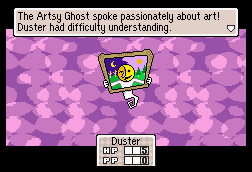 EarthBound
EarthBound was already a fairly user-friendly piece of software (especially compared to
MOTHER), but
MOTHER 3 cuts players even more of a break. There's almost
never any ambiguity as to where you should go or what you should do: if you're not given explicit instructions as to your next move, someone in the vicinity will clearly spell it out for you. Just to make sure you don't get lost when your destination might be a wee bit unclear, there are actually arrows (well, arrow-shaped lizards) that will literally point you in the right direction. The environments are even smaller and more hemmed in than before. There are fewer enemies running around, and now almost none of them are randomly spawned; their positions in the field are scripted. You no longer have to worry about getting jumped by gang members or chased by sentient child-eating taxicabs while wandering around town (and there are only
two towns in the whole game). There are fewer items to keep track of, and the store menus will tell you exactly what they do (whereas in
EarthBound, you had to shell out money and then examine the item in your bag). Just about every dungeon (and the word "dungeon" must be used loosely in
MOTHER 3) contains a frog (save point), and many contain hot springs. Detailed maps for almost every area, including the haunted castles and Pigmask strongholds, are routinely handed over to you.

I have mixed feelings about these changes, sure. But if I had to fall on one side or the other of the streamling vs. dumbing down question, I'd be less inclined to say
MOTHER 3 is dumbed down. The "dungeons" are generally short and fairly straightforward, but I often found them hitting that narrow sweet spot between "what, that's it?" and "oh god there's MORE?" And there's no denying that
MOTHER 3's battle system and relata are much tighter than
MOTHER or
EarthBound's. There are fewer enemies running around, yes, but they're consistently
tough, and the boss battles are indisputibly the most challenging in the series. Even the combo system,
MOTHER 3's only new addition to the battle sequences, only serves to help you eke out victories against the likes of Mr. Generator, Fassad, and the Barrier Trio without having to spin your wheels on level grinds.
But in any case, these kinds of changes from previous iterations of
MOTHER serve the same purpose as they did in
Final Fantasy VII: they help the player move through the game and devour the story at a faster pace. There's a kind of satisfaction in finally getting through a dungeon and beating a boss, in earning the right to advance after an hour or two of harvesting enemies for gold and experience points. But it's also kind of insulting to be told your numbers aren't high enough to earn admittance to the next area of the game or the next chapter of the story. Itoi is more of a classic writer/storyteller than a full-blooded game developer; now that the RPG has crawled out from the primordial ooze of the 1980s from whence
Ultima and
Dragon Quest were formed, he sees no reason to let the stat numbers and equipment and enemy encounters exert more ohms against the current of the plot more than is necessary.

Right. The plot.
MOTHER and
EarthBound both place their emphases on exploration, but
MOTHER 3 is largely plot-driven. Although we could try to write up a list of characteristics that define an RPG as exploration-driven (like, say,
Dragon Warrior or
Final Fantasy I) or plot-driven (like
Final Fantasy IV), it might all be arbitrary. We'd beginning with a premise of misattribution; it would be like people discussing the particulars of piano tuning while believing that the sounds emerge from its keys rather than its strings. The motive force of any RPG, any game, is the player's thumb on the joystick. In any RPG, you guide your little in-game avatar through the environment of the game until you reach some obstacle that prevents you from proceeding any further. You poke around the area already open to you until you find a means of surmounting the obstacle, and you proceed into the new area until you come across some other obstacle, and you repeat this until the game tells you congratulations, you've made it to the end.
Maybe the fundamental difference is this: are you pressing your thumb to the joystick because you want to see what lies ahead, or because you want to see what happens next?

Of course, we could just as easily equate one to the other. Maybe the only difference is the amount of time one spends hitting the "confirm" button while watching the characters in the game talk to each other. And you do a
lot of this in
MOTHER 3 compared to
EarthBound.
EarthBound has a lot of text, sure, but most of the people Ness meets just stand still and deliver monologues to him. "Cutscenes" abound in
MOTHER 3. You'll frequently sit and observe conversations between two or more characters, and they're rarely standing still while they speak. They gesticulate, they pace, they run through situtionally unique animations. This is as new for the
MOTHER series as it was for
Final Fantasy in 1991. It makes for a very different kind of trip than
EarthBound; but
MOTHER 3 aims at a totally different target, and uses a different toolkit to hit it.
If
MOTHER and
EarthBound are both fairly uncomplicated mutations of the Hero's Journey of myths and epics,
MOTHER 3 might be more like a post-1900 novel. The basic outline of the picture is mostly extant: there's the summons to adventure, the journey outside the world of the familar and the sequence of trials therein, the acquisition of special treasures and powers, the battle with the archvillain and the restoration of the world—but now it's become more layered, more nuanced, more complicated. Many more perspectives are involved than before, and some degree of ambivalence has crept in. What's more, the size of the stage has shrunk, and so the show is a much more intimate proceeding than its Broadway-sized predecessors.

This might not have been the case for
EarthBound 64, had it come to fruition. In
a long 2006 interview with Nintendo Dream Magzine (translated by Tomato, of course), Itoi and his interviewer discuss how
MOTHER 3 ended up being a lot less dark than was called for by the blueprints to its cancelled prototpye:
[Interviewer:] So why did the GBA version end up with the lightened scenario?
Itoi: (pauses to think)... I guess I became a good person.
[Interviewer:] (laughs)
[Interviewer:] Did your loyal MOTHER fans have any influence in your becoming a "good person"?
Itoi: Not at all. I can profess right now that I haven't been changed by the fans. If that were the case, then Yujiro Ishihara and Ken Takakura would be different people now, because of me. (laughs) I am grateful for the messages from my fans. It makes me happy, but it's certainly not like that's all it takes to change a person. It's not like that. You can't just make it so you're influenced by people.
 [Interviewer:] Well that's a bit rude!
[Interviewer:] Well that's a bit rude!
Itoi: No, no. The big thing here is the group of people around me. Like if an employee gets married or something.
[Interviewer:] I see.
Itoi: When we made MOTHER 2, there were practically no married men with us at all. People who are involved with the development of a game are like a group full of weirdos, infecting the air with this pretentious attitude that blashphemes anyone who wouldn't look forward to all-nighters [on the project]. Gaming magazines are the same way. (laughs)
[Interviewer:] The editing department is crawling with singles. (laughs)
Itoi: As if to say, "If you're looking for a normal sense of happiness, you're better off going to a respectable company!" (laughs) There was a time when thinking stuff like that gave a person a solid feeling of pride. Same as someone boasting, "Man, I smoked too many cigarettes and I feel sick now."
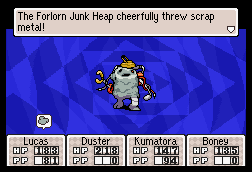 [Interviewer:] (laughs)
[Interviewer:] (laughs)
Itoi: But looking at it now, I see for example how happy I am if a co-worker has a child, and how truly sad I feel when an employee falls ill. So it's like I have literally become a father, myself. So if I put up some pretense and die from it, I've got nothing to show for it. I can't do my job well if I'm too busy coughing from cigarettes. (laughs)
EarthBound was about exploring huge a new videogame world, and to some extent, about examining the experience of exploring a video game world.
MOTHER 3, ten years removed from
EarthBound, is primarily concerned with
people.
With that in mind, let's begin our customary survey of the game's
PEOPLE & PLACES
NOWHERE ISLANDS
The first two
MOTHER games were set in fictional fascimilies of late 1980s and early 1990s North America. This was one of the series' gimmicks from its inception: while other console RPGs took you to medieval fantasy and/or high-tech sci-fi worlds,
MOTHER remained on Planet Earth in the twentieth century, and was hardly any less fantastic or strange for it.
MOTHER 3 mixes things up a bit. From the onset, all we know is that its events occur in a place called the Nowhere Islands. The location of the islands in space (Earth) and time (the distant future) are kept secret until the final hours of the game.

What's more interesting to me than Itoi's removing the series from a recognizable modern-day Earth and into a fantasy setting is the relative smallness of the new venue.
It's a reversal of what we see in RPG series like (oh, which to choose)
Final Fantasy. The original
Final Fantasy's world map was huge for 1987, but over three console generations it was successively dwarfed by the twin planets of 1992's
Final Fantasy V, the vast and varied world of Gaia in 2000's
Final Fantasy IX, and the repulsively titanic Ivalice of 2006's
Final Fantasy XII. MOTHER, meanwhile, appears to have been shrinking.
MOTHER's Rural America, as we've already seen, was defined by sprawling open spaces and long, dangerous paths between its towns. There's probably no practical way of comparing the number total of traversible tiles in each game, but
EarthBound often
feels smaller than
MOTHER, since it does away with so much of that blank space. And compared to
EarthBound, MOTHER 3 seems teeny-tiny. Again, I'm not about to open up all the maps of all three games and take their measurements, but I wouldn't be the least surprised to find that
MOTHER 3's dimensions are the smallest.
To illustrate the series' shrinking act, let's compare some maps.
From
MOTHER: Yucca Desert
From
EarthBound: Dusty Dunes Desert
From
MOTHER 3: Death Desert
From
MOTHER: Snowman
From
EarthBound: Winters
From
MOTHER 3: Snowcap Mountain
From
MOTHER: Mount Itoi Plateau
From
EarthBound: Peaceful Rest Valley
From
MOTHER 3: Drago Plateau

The Nowhere Islands are just about as varied as Eagleland and its neighboring countries, featuring all the requisite console RPG backdrops. You have the graveyard, the haunted house, the volanic caves, the snow fields, the desert, the jungle, the high-tech dungeon, the mountain path, the underground maze, the sewers, etc. They're just a lot smaller—and, for the most part, much richer.
EarthBound traded the sweeping open spaces of
MOTHER for smaller, more detailed environments, and
MOTHER 3 follows suit, shrinking the maps even further, but making more intentional use of its spaces.
Is this an instance of streamlining of of dumbing down? The answer probably depends on how you like your RPGs. But it's an apt change for a game that's taken a different aim than its predecessors.
MOTHER and
EarthBound were adventure stories about a boy setting out from home to find out where the horizon ends, and a hero must have a suitably expansive world to explore.
MOTHER 3, however, is largely a drama about a family and the community to which it belongs, and so the dimensions of the stage must be commeansurately smaller.
TAZMILY VILLAGE

A familiar trope in console RPGs: a person of uncommon talent and potential is galvanized by the call to adventure and sets out from his remote little village into rolling vistas of the unknown, where fantastic trials and transformations await him. Leaving home, the demense of the familiar, is necessarily the first step. In more traditional and linear media, it's often the case that the hero of an adventure story doesn't cross back into the presincts of his community until his journey is concluded, his tests overcome, his ogres vanquished.
But video game heroes usually enjoy more flexibility and mobility. RPG heroes might have the means to return home, but there usually isn't much point in taking them there. You can guide your RPG crew back to their old stomping grounds, but the people they speak to will usually tell them precisely the same thing they did when seeing them off five or ten game hours ago, and the weapon and armor shops are still peddling the same rusty, obsolesced wares. It's often as though the town becomes frozen in time at the moment of the hero's departure.
For the most part,
EarthBound is no exception to this. Between Ness's egress from Onett and his return after his apotheosis in the Fire Spring (when Onett
has changed), he has only one (1) occasion to return to his hometown on a small errand to retrieve a library book. Onett is in Ness's rear miror for the greater part of his adventure, and most of its people become irrelevant as soon as he setttles his business with the Onett Police Department and moves on.

But the heroes of
MOTHER 3 never stray far from Tazmily. And for as long as we see Tazmily, it's never quite the same place from one day to the next.
Tazmily is unusual for a console RPG hometown. Most RPG heroes' home villages are populated by nameless people with generic character sprites. Though it might be the case that the hero has known the villagers for his entire life, the game will treat them as a bunch of nobodies. Who are these people? What do they do? Who cares? It isn't important.
Each of Tazmily's 43 residents (if I'm counting correctly) has a name and their own unique sprite, and their place in the community is usually made clear. Lighter is a lumberjack; he is assisted by Bud and Lou, he has a son named Fuel, and he's close friends with Flint. Bronson is the blacksmith and apparently the de facto constable. Jackie and Betsy oversee things at the Yado inn and tavern, and their employee Tessie also serves as a nurse. Abbey the florist is married to Abbot. Thomas runs the bazaar; his wife is Lisa (a close friend of Hinawa), and their children are Nichol and Richie. Caroline is a baker; Angie is her daughter. And so on. And you can't but get acquainted with them all in the first half-hour of
MOTHER 3: almost everyone pitches in to help look for Hinawa and the kids, and most of them turn out for the funeral the following day.

When we first step into Tazmily, it seems like the podunk of podunks: it's tiny, it's situated literally in the middle of Nowhere, and it doesn't have access to anything but the most basic comforts: virtually every structure in town is constructed from lumber, the houses are lit by candles and lanterns, and there's no electricity or running water. It's a peaceful, stable place, and as far as we can tell, the villagers enjoyed it this way. We have to use "enjoy" in the past tense, since we never get to see what life in Tazmily was really like before the Pigmasks start in.
Three years after Hinawa's death and the arrival of Fassad and the Pigmasks, Tazmily is a very different place. In the wake of its rapid modernization, we find paved roads, houses with electricity and all the modern amenities, and a burgeoning population. We're introduced to the same Tazmily at the same time we take control of Lucas, who now looks much more similar in stature to Ness. So at the same time that we take control of a character who looks like the hero of
EarthBound, we find ourselves in a place that suddenly looks a lot like Onett. It's a clever trick: the nostalgic
EarthBound fan will be inclined to be overjoyed, but it's hard for her not to experience some cognitive dissonance when she knows that the drivers of these changes are following a sinister agenda that probably doesn't have the best interests of the villagers in mind.

It's odd, though: the Tazmily scenario becomes inversion of the usual Trouble in River City trope of the console RPG. You know how it goes: the hero is spurred to action because his hometown is plagued by some inimical outside agency. Examples off the top of my head: Guardiana in
Shining Force is invaded by the marauding hordes of Runefaust. Rabanastre in
Final Fantasy XII is under occupation by the oppressive Archadian Empire. Roccoco in
Robotrek suffers from the machinations of the Hacker gang.
Grandia II's Carbo village is beset by nocturnal terrors. Strange things are happening around Podunk and Onett in
MOTHER and
EarthBound as a malign alien influence takes root. But in
MOTHER 3, the darkness that descends upon Tazmily Village is...uh, technological improvement and material prosperity. While almost everyone in town tells Lucas how much better off they are now than they were three years ago, our hero finds himself compelled to work against and subvert his village's benefactors. Huh.
Although the Tazmilities are seduced by Fassad's missionism and invite the Pigmask Army into their town, they never really become
evil people. Abbot and Abbey become born-again consumer whores and treat Lucas with condescension for not keeping pace with the times, but when we last see them they're looking out over the city lights and talking about their love and devotion to one another. This is the sort of ambivalence that haunts
MOTHER 3—a story of decent people who are prone to misdirection, strong-hearted but flawed heroes, cruel men who do kind things, and malevolent demons deserving of pity.
HINAWA
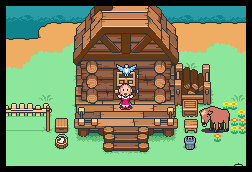 EarthBound
EarthBound began the same way as
MOTHER, and
MOTHER 3 begins the same way as
EarthBound: by asking you to assign names to a few people, and then to name Your Favorite Food and Your Favorite Thing. In the first two games, the characters being named stand against the backdrop of a menu screen, and their future relationships as travelling companions is implied only by the fact that you're being asked to name them in the first place.
MOTHER 3 departs from its antecedants by placing the conventional naming screen windows in front of a house, and showing the characters in question interacting with each other. Even before any actual narration begins, we're aware that the people we're looking at and christening comprise a family with two parents, a pair of twin sons, and a dog.
If you go by the default names, you get Flint, Hinawa, Claus, Lucas, and Boney. The husband/father Flint is the player character in Chapter 1. The younger twin Lucas takes the wheel from Chapters 4 through 8. Boney is party member in six of the eight chapters, and there's a moment in the prologue when Claus joins Lucas in a joke tutorial battle against a rambunctious mole cricket lookin' to wrassle. The only family member who's never a usuable character is Hinawa, the beloved wife and mother.

Until now, the title
"MOTHER" has always possessed some kind of abstract or oblique significance with regard to the game it represents. Itoi's first game was named after a John Lennon song: he was struck by the rawness and the conflicting emotions with which the word was sung in refrain after refrain, and it comes to refer to Giygas's irreconciliable but mutually persistent loathing of humanity and love for Maria. In
EarthBound (ahem,
MOTHER 2), the word probably refers to the Earth itself. We don't need to look very deeply to see the word's meaning in
MOTHER 3: it refers to Hinawa. And that's why we'll start with her. She is, in a manner of speaking, the titual character.
We never learn much more about Hinawa beyond what's inscribed on her gravestone:
Wife of Flint.
Mother of the twins Claus and Lucas.
Daughter of Alec.
May the beautiful Hinawa rest in peace here for all time. Perhaps it doesn't say very much about the personality of the woman herself, but nothing exists but in relation, and this is especially true in such a small and mutually interdependent community like Tazmily. It's probably enough to say that Hinawa is presented as the angelic ideal of the nurturing, protective, self-sacrificing wife and mother, and for the purposes of this narrative, she doesn't need to be a Molly Bloom. She's considered almost entirely in retrospect, and through the actions and recollections of her grieving husband and children. ("Real love," Tony Kushner writes, "is never ambivalent.")

Like
The Sound and the Fury, MOTHER 3 has at the center of its family drama the empty space left behind by the woman who isn't there. Hinawa dies half an hour or so into the game. She's barely seen onscreen and hardly gets any lines, but her absence is felt throughout the entire game. Almost every action undertaken by Flint, Claus, and Lucas is, in one way or another, in response to her death. (The entirety of Chapter 6 consists of Lucas literally chasing her ghost.)
Back to the naming screen:
MOTHER 3 uses the now-familiar "what's your favorite food?" prompt to play a mean trick on veteran players who go into the game thinking they know what to expect. In the first two games, you could always count on being able to walk or warp back home, where you could talk to Mom and let her serve up a heaping plate of Your Favorite Food for some cost-free HP/PP recovery. This never happens in
MOTHER 3. The only time we see Lucas enjoying the flavor and magical healing properties of Your Favorite Food is during the prologue, when he sits down with Hinawa and Claus for what will be their final meal together. Throughout the game, Your Favorite Food is sporadically mentioned, but only as a tease: you won't find it in any store, it's not sold in any vending machines, and Lucas will always return home to an empty house with an unset table.
CLAUS

As long as we're making spurious analogies to
The Sound and the Fury, why don't we go ahead and and point out the areas of overlap between Claus and Quentin Compson? They're the lost sons and brothers; both go off and do something crazy and suicidal for the sake of the missing woman in their respective stories. Quentin is so haunted by his memories of his sister Caddy, so utterly lost in both his family and the world without her, and so pounded into self-hatred and despair by the discrepancies between the chauvenistic ideals of the moribund culture he's been made to internalize and the sordid realities of life, that he throws himself into the Charles River and drowns himself. Actually, Quentin's story is pretty complicated, but Claus's motivations are much simpler: a Drago (an ordinarily friendly kind of Tyrannousaurus indigenous to the Nowhere Islands) that's been chimerized and corrputed by the Pigmasks kills his mother, and he runs off into the hills by himself with his dad's knife, bent on a retribution killing. He's never seen alive in Tazmily again.

From what we know of Claus, he seems much more similar to
EarthBound's Ness than Lucas does. None of the kids in Onett ever stop yapping about how strong and brave and cool Ness is, while Claus is the headstrong, adventurous yang to Lucas's timid, lachrymose yin. And on the face of it, the beginning of Claus's story is a lot like Ness's, too: when his family and their hometown are beset by paranormal forces, he immediately sets out from home on a mission, armed only with a household implement and some psychic powers he picks up during the first leg of his journey. (Lucas's adventure in Chapter 4 begins much more haphazardly, and with much less dramatic flourish.) But unlike Ness (or Lucas, for that matter), Claus has the misfortune of receiving a crippling injury that prevents him from fulfilling his goal or returning home, and Destiny hasn't allotted him a retry screen in the event of such a disaster.
This isn't the end of Claus's story, of course, but we'll come back to him later.
FLINT

How's this for an inversion of expectations: after two
MOTHER games where the young hero's father is never seen in person,
MOTHER 3's version of "Dad" not only has a proper name, not only appears in the flesh, but is actually the player character during the first chapter.
Flint looks like a cowboy, but he actually tends sheep. What else do we know about Flint? Not much, really. We're told in the naming screen that he's a strong, kind, dependable father. It's not much, but it's all we get. He goes mute as soon as the character takes control of him at the beginning of Chapter 1. Afterwards, he becomes an NPC for the remainder of
MOTHER 3, and it seems he's not quite the same man he was before. "Kind" and "dependable" aren't words that describe the Flint we see after Hinawa dies (the surprising emotional rawness of the scene where he gets the news should be taken as an admonition by anyone in the business of writing video game narratives) and Claus goes missing. Three years after the arrival of the Pigmasks, all he does is wander up in the hills, searching for Claus. Sometimes he comes back for a few minutes to lay a fresh boquet of flowers on his wife's grave. We might have to assume that he's also coming back every now and then to rebuild the old ranch whenever it gets struck by the Pigmasks' lightning. It's a wonder he actually bothers: the only person who spends any time at home is Lucas, who's clearly on the outmost periphery of Flint's concerns.

The irony of finally having a human father instead of a voice on the phone in a
MOTHER game is that Flint becomes even more distant from Lucas than "Dad" was from Ness in
EarthBound. Dad is always just a phone call away, and unless you're playing on an emulator and using savestates, you'll be talking to him frequently. Except for the very beginning and very end of
MOTHER 3, Flint is almost as absent a figure in Lucas's life as his dead mother and vanished brother.
For all of
MOTHER 3's quirkiness, all of its talking mole crickets and carousing ghosts and magical drag queens and absurd chimerical animals, it can't be overlooked that it's basically a story about a broken family. (Just like
The Sound and the Fury! Give me a break, I love that book.)
There are two wonderful moments involving Flint at the end of the game that are deserving of mention. The first is when Flint goes off ahead into the "Cave of the Future." As Lucas catches up, he find his father's hat drifting through the air and disappearing over the abyss. Further ahead, we find Flint. The camera pans to show a hatless (and bald) Flint by himself on his hands and knees, looking utterly old and broken and alone. It's an important moment; it plainly shows the completeness of Flint's desolation at that point, but it's also very brief, uncomplicated, and untheatrical.

As Lucas and Boney crouch over him, he says to Lucas (without turning around to look at him): "that masked man...He's Claus. Lucas... He's your brother... Claus. [...] As a father, I've finally found the son I lost. Lucas. Be happy. I've finally, finally found your brother." He ends there, and says nothing further unless you approach and
speak to him again.
*
How are we supposed to feel about this? How should
Lucas feel about it?
Should he be happy? After all, Lucas never seemed to share his father's morbid obsession with finding Claus. Does Flint's belated success do anything to cancel out the three years of paternal negligence to which he subjected the son who was still with him? Who knows? When I said earlier that
MOTHER 3 is more infixed with ambiguity than
MOTHER or
EarthBound, this is exactly the sort of thing I was talking about.
At any rate: Flint is not only a character in the story, he's also your sole party member for most of Chapter 1. Though he's incapable of psychic attacks, his Brute Force abilites let him power himself up, hit all enemies at once with a physical attack, or sacrifice accuracy for increased power. As such a straightforward physical fighter, he's an evolved (and less boring) version of Teddy from
MOTHER.
*I'm betting Itoi hid Flint's remarks to Lucas about his glabrous noggin behind as many repetitions of the same line because they rather detract from the gravity of the moment. But it's nice that the speech is there if you look for it, and such are the advantages of a nonlinear medium.
LUCAS

Ah. Here we are. Ness—savior of the universe in
EarthBound, the bravest, strongest, most bad assed boy in the world—is succeeded in
MOTHER 3 by Tazmily Village's resident weakling and crybaby. Ness has what it takes to go off on a quest to save the Earth from the very beginning of his story; Lucas doesn't even demonstrate his latent moxy until the end of Chapter 3, and then has to wait another three years before destiny comes a-knocking again at the beginning of Chapter 4.
Actually, Lucas is a lot less like Ness and a lot more like
Final Fantasy Tactics' Ramza, the coddled, privileged runt of a military cadet who takes a stand against the whole fucking world. Lucas is a blonde-haired late bloomer of an RPG protagonist, sure, but he shares two specific traits with Mr. Belouve. The first is that he's a kind and thoroughly decent kid who is able to win allies to his side. The most important case in point are the Dragos: when Hinawa is killed by a modified Drago, Claus responds by going out and trying to kill it. (His dialogue might even imply that he wants to kill
all the Dragos, but we could be reading too much into it.) When Flint sets out to find Claus, he comes across the Drago that killed Hinawa and mortally wounds it, angering its child. And then it's Lucas who goes out, finds the remaining Dragos, reconciles with them, and brings them to Duster and Kumatora's aid when they're cornered by Fassad and a squad of Pigmask soldiers.

Secondly: like Ramza (and unlike Ness), Lucas is a pariah. His situation might not be as grim as Ramza's (branded as heretic, traitor, and anarchist), but three years after Fassad and the Pigmasks arrive, he's become a persona non grata around Tazmily. He's the son of that whackjob Flint, after all—an outlier to be regarded with suspicion or condescension, or to be avoided altogether. Lucas's first mission is to search for the missing Duster, whom none of the other villagers are interested in finding, and to foil a villain seen by the rest of Tazmily sees as a friend and benefactor. When his status as the "the chosen boy" becomes clear, Lucas is subsequently tasked with seeking out and pulling the Seven Needles to awaken the Dark Dragon sleeping beneath the Nowhere Islands, which could well mean the end of Tazmily. It's all very true to life: doing what's right often doesn't make you popular.
Even if we were to conclude that
MOTHER 3 has been dumbed down as an RPG (and we're not), we'd still have to give it credit for doing a much better job at balancing the attributes of its player characters then either
MOTHER or
EarthBound. Lucas, as you might expect, handles a lot like Ness in battle, but with some notable differences. He's still the strongest physical attacker, he still inflicts negative status effects with PK Flash, he still serves as a healbot with all four versions of PK Lifeup, and he still commands the nuclear option with the pricey but unparalleled PK [Your Favorite Thing]. But now he's also become the team's assigned bufferizer—and given how much stronger
MOTHER 3's bosses are than
EarthBound's, your crew needs every edge it can get. But he's no longer the one with the most HP or PP, and now he's also
slowest party member, always taking his turn last.
MOTHER 3 still uses
EarthBound's rolling HP bars, which means there's always a chance that PK Lifeup Omega might come out too late.
DUSTER

Think for a moment: what's one thing that nine out of ten JRPG goodguys have in common? Aside from an unusual resilence to planet-consuming cosmic explosions and gunfire, I mean. And also aside from the innate ability to pilot any given land, air, or seafaring vehicle, now matter how advanced or alien its engineering might be. And apart from being ineffective at sniffing out the obvious subterfuges of obvious villains.
Answer: they're all attractive and well groomed! With the exception of the occasional "old man" stereotype or "freak" party member, just about every character in every modern Japanese RPG has the type of face that would perform quite admirably on Tinder, and dresses with a conscientious (though not always well-advised) sense of style.
And that's why I'm so fond of Duster, Tazmily's resident gentleman of the shade. He's a JRPG hero with a horse face. And he's shabbily dressed and poorly groomed, and he's got bad breath, a big wart or mole on his face, and an ill-advised mustache.
And he walks with a steep limp because of a bum leg.
(It's funny: most of the people drawing
MOTHER 3 fan art seem incapable of accepting this. Their renditions of Duster frequently diverge from his in-game appearance, shrinking his nose, smoothing out the shape of his head, styling his hair, and so on.)

And I like Duster even more because he had to win me over. Seeing him the the early screenshots of
MOTHER 3, I reacted like any orthodox fanboy: "WHO THE HELL IS THIS AND WHY ISN'T HE A LOID/JEFF CLONE?" Fifteen minutes into Chapter 2, where Duster Indiana Joneses his way through the haunted Osohe Castle in search of the mysterious Hummingbird Egg relic,
EarthBound somehow seemed poorer for not having a muttonchopped shinobi of its own. Acquired tastes are the ones we savor most, after all.
Duster is a new sort of party member in the
MOTHER series. Loid was a geek with a talent for gadgeteering who could occasionally come in handy when you figured out what items to put in his hands, knew where to find them, and went to the trouble of collecting them. His successor Jeff could be tremendously, game-borkingly powerful if you figured out what items to put in his hands, and they really weren't that hard to find. So
MOTHER 3 starts from scratch, replacing the engineer-type character with that tried and true RPG staple, the thief. But Duster doesn't steal—instead he packs six reusable Thief Tools (which sit in the Key Items box, keeping his inventory uncluttered) that inflict negative status effects and debuffs on individual enemies at no cost. Neat! He's also the second strongest and second fastest character, and he's got the most HP. Neat! And he occasionally acts at the start of battle, getting in a random first hit before the command window appears, or reverses the situation when an enemy surprises the team from behind. Neat! (It was because of Duster that I learned that hitting an Atomic Power Robot when its back is turned disarms its self-destruct device. Nice touch. And also neat!)
KUMATORA

When we looked at
EarthBound, we compared Paula to Ana, her predecessor in
MOTHER. Now: let's compare and contrast Paula with
Kumatora, MOTHER 3's heroine.
Paula is an ingenue sweetie pie raised by a waspy couple who own a preschool. Kumatora is a tomboy punk raised by a tribe of immortal transvestites/-sexuals/-somethings. Paula hits enemies with a frying pan because she's a girl. Kumatora attacks enemies with her fists because she's had enough of their shit. Paula fries the opposition with deadly elemental psychokinesis. Kumatora fries the opposition with deadly elemental psychokinesis. Paula wears a modest pink dress and ties bows in her blonde hair. Kumatora wears a hoodie and lets her pink hair do whatever it wants.
Paula is sweet and polite. Kumatora is brash and brusque. Paula sits in a cell with her teddy bear and waits for Ness to come rescue her. Kumatora gets caught in a beartrap is about to cut her foot off when Wess and Duster happen upon her. Paula falls in love with Ness. Kumatora doesn't show much interest in either of her male party members. Paula might be named after pop music footnote Paula Abdul. Kumatora's name literally means "beartiger" in Japanese. Paula prays. Kumatora curses.
Told you before I was more of a Kumatora fan. Still, it would have been nice if one of Itoi's female characters got her own extended chapter in one of his games.

As a party member, Kumatora is par for the course. She alternates with Boney as the group's weakest physical attacker (her base stat is lower, but she enjoys more frequent equipment upgrades), and has the second-lowest HP and speed, but she's the only party member other than Lucas to wield PSI, and her PP is usually higher than his. Her psychic aresenal is something like a conflation of Paula's and Poo's: she gets all the offensive elemental PSI in addition to debuffs, status afflictors, some basic recovery techs, and PK Starstorm. Protip: if Kumatora learns PK Ground, you're definitely overleveled.
Interesting: like the enemies of
EarthBound (and most other RPGs), most of
MOTHER 3's baddies are variously resistant against and susceptible to fire, ice, and lightning elemental attacks. But this time around, Kumatora is pretty much the only character to whom these attributes have any relevance. Would you call this streamlining or of dumbing down?
BONEY

We've already discussed the ungainliness of fourth characters in our overview of
EarthBound—they're problematic in that they're too often just one superfluous figure added to the magical triangle.
MOTHER's fourth man was Teddy, the boring gang leader.
EarthBound's fourth man was Poo, the incongruous and redundant karate prince.
MOTHER 3's fourth man is Boney, the wonder dog. Unlike Teddy and Poo, Boney never seems like an afterthought, as he's with Flint at the very beginning and immediately joins Lucas at the start of Chapter 4. Perhaps he helps keep the special Hero/Buddy/Girl triad intact because he and Lucas count as a single conjoined character—sort of like Dorothy and Toto.
Boney's only antecedent in the series is King, who joins Ness to look for Picky on the night the meteor crashes up in the hills. King is reluctant to go out to begin with; he chickens out and runs home before he even gets to the top of the hill (and to be even more of a wimp than Pokey takes some work), and for the rest of the game he just mopes indoors and refuses to go out. King is really kind of a shitty dog.
But Boney is the superpet superpal an RPG hero deserves. Unlike King, Boney doesn't need to be coaxed into helping out: if Flint or Lucas try walking past him, Boney will run up and demand to be taken along, and won't take no for an answer. At the beginning of Chapter 4, Lucas is alone—his mom is dead, his dad is never around, his brother is long gone, and the people of Tazmily distrust him—but he can still trust Boney to be at his side. Boney is the perfect dog, steadfast in his loyalty and willingness to take care of the family he loves. He melts my heart.

In battle, Boney might not seem to have much going for him. His special ability lets him sniffasniffasniff an enemy to learn its weaknesses—which isn't really that special, since it's usually easy enough to guess. He has the least HP, and he's not the strongest attacker. But unless he's significantly underleveled, Boney's high speed stat makes him consistently the first party member to act during a given round in battle. He's the one you load up with HP recovery and status-curing items to save your crew from rolling down to zero, and make sure an ally's status effects are cured before his or her turn comes up. (He's also the one you give the Shield Snatcher to if you're lucky enough to find it.) Boney's his combos are also the most fun to listen to, and that counts for more than you might think. (Some players have suggested that his sharp, discrete notes actually make his combos the easiest to perform. Maybe that's the reason why I tend to score more hits with him than anyone else?)
SALSA
I had to do a lot of thinking to figure out just why Salsa the dancing monkey is actually in
MOTHER 3 at all. He's the player character during Chapter 3, and then disappears until he's needed to open a door in Chapter 7. For the rest of the game, he doesn't do much of anything else. He's not much fun to play as: his damage output is pitful, his Monkey Tricks are mildly amusing rather than useful, and Fassad does most of the actual work in battle. His "deliver four boxes to four select villagers in under twenty-three minutes" mini-game (and we use the word "game" very loosely) could be Figure 1 in the dictionary entry for "RPG busywork," although I guess being made to feel enslaved is nothing if not "immersive."

So why turn a whole chapter over to Salsa? Pure chutzpah, maybe: to the best of my knowledge, no other RPG has ever had the imagination or the balls to put players in the role of a monkey held captive by a mephistophelean huckster who tortures him and forces him to dance. But more practically, it's an effective means of providing exposition for Fassad and the Pigmasks from the embedded perspective of a hostage who's seen what they're up to and can't tell anybody about it (except for the psychic Kumatora). That makes Salsa a cute little plot contrivance: we need to know that Fassad feels nothing but contempt for the people of Tazmily, and there also needs to be a good reason for Kumatora, Wess, and Lucas to run afoul of him and see him when he's not putting on his benignant act for the townsfolk. (It might also be that having a third new player character in as many game chapters is a clever, subtle means of conveying the extent to which the Pigmasks' arrival has destabilized the Nowhere Islands: things have become so unsettled that not even the main character of the game can remain consistent for more than a couple of hours at a time.)
THE MAGYPSIES
Want to know why
MOTHER 3 ain't never getting an official North American release? This might be at least part of the answer.

Late in
MOTHER 3, Lucas is dispatched on a lengthy "find the seven plot tokens" quest. Two unusual things about this: one is the timing. Ninten and Ness were both implicitly or explicitly given their "find the Eight Melodies" assignments at the very beginning of their games, and they spend most of their respective adventures tracking them down. It's not until Chapter 7 of
MOTHER 3 that Lucas is tasked with his own RPG scavenger hunt, and it's compartmentalized into its own chapter rather than being suffused throughout the whole affair. What's more, MOTHER 3 diverges from the old script by eschewing musical notes as the object of the quest. This time, our hero has to locate and pull out the Seven Needles stuck into the pressure points of a colossal dragon sleeping beneath the Nowhere Islands.
Each of these needles is attended by an ageless, magical maiden named after one of the Greek musical modes: there's Aeolia, Doria, Lydia, Phrygia, Mixolydia, Ionia, and Locria. They're also natural PSI users, and were the ones who awakened the latent powers in Claus, Lucas, and Kumatora. So far, so good.
Also, each of these maidens is also a dude. Kind of.
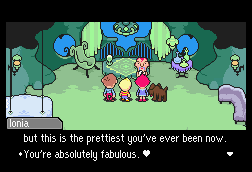 It's a reversal of what we usually think of "androgyny." Usually the term evokes a personal aesthetic in which the more salient aspects of both sexes (and their typically associated genders) are dampened, resulting a person who might seem vaguely masculine, but somewhat feminine as well. The Magypsies, on the other hand, are extremely masculine and extremely feminine at once. Their voices are indescribably deep, yet shrill. They have visible stubble and the hard outlines of male faces, but they mince about like debuntantes. And they...
It's a reversal of what we usually think of "androgyny." Usually the term evokes a personal aesthetic in which the more salient aspects of both sexes (and their typically associated genders) are dampened, resulting a person who might seem vaguely masculine, but somewhat feminine as well. The Magypsies, on the other hand, are extremely masculine and extremely feminine at once. Their voices are indescribably deep, yet shrill. They have visible stubble and the hard outlines of male faces, but they mince about like debuntantes. And they...
Actually, the Magypsies are just a great big mishmash of gay crossdresser stereotypes. One gets the sense that they'll go down in video game history the way the crows from Dumbo are remembered by animation historians who apologize and shake their heads. But heck: it's hard not to like the crows in spite of everything, and I doubt you'll find many MOTHER 3 players who weren't won over by the Magypsies. And everyone in the world of MOTHER 3 likes them too. Nobody says they're not strange—that's readily admitted—but people seem more impressed by their kindness, wisdom, and beauty. "Delight is to him," says Herman Melville, "who ever stands forth his own inexorable self," and the Magypsies are never anything but delighted to let their freak flags fly.
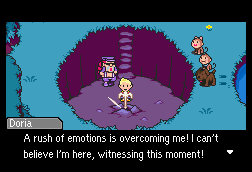 This time through MOTHER 3, I was less interested in the Magypsies' genderingbendering strangeness than in their attitudes towards mortality. When they speak to Alec and Flint in Chapter 1, they have a flippant, almost disdainful attitude towards human life. What concern is a human lifespan to someone who's lived thousands of years, and expects to live for at least a few thousand more?
This time through MOTHER 3, I was less interested in the Magypsies' genderingbendering strangeness than in their attitudes towards mortality. When they speak to Alec and Flint in Chapter 1, they have a flippant, almost disdainful attitude towards human life. What concern is a human lifespan to someone who's lived thousands of years, and expects to live for at least a few thousand more?
But when the Needles they protect are pulled, the Magypsies disappear. This means that once the Masked Man begins removing the needles and gets the process underway, the Magypsies must be erased from existence, one by one. Maybe they're entitled to be a little condescending towards human attitudes about death, since each of them (except maybe for Locria, but that's another discussion entirely) is the very model of grace and humility when her own number is called. Only in a MOTHER game would one expect to find such a marriage of frivolity and wisdom.
DCMC
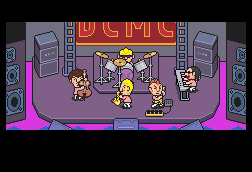 Happy Boxes aren't the only form of decompression enjoyed by Tazmily's working stiffs a long day of grinding labor at the Clay mines. The factory workers all get free passes to Club Titiboo, where they can suck down booze, enjoy the attention of cute cabaret girls, and watch live performances by DCMC (Desperado Crash Mambo Combo), the hottest band on the Nowhere Islands. And what are the DCMC's songs about? Why, King Porky, of course!
Happy Boxes aren't the only form of decompression enjoyed by Tazmily's working stiffs a long day of grinding labor at the Clay mines. The factory workers all get free passes to Club Titiboo, where they can suck down booze, enjoy the attention of cute cabaret girls, and watch live performances by DCMC (Desperado Crash Mambo Combo), the hottest band on the Nowhere Islands. And what are the DCMC's songs about? Why, King Porky, of course!
The DCMC—composed of OJ, Magic, Baccio, Shimmy Zmizz, and Lucky (actually an amnesiac Duster)—are obviously heirs to EarthBound's Runaway Five. Individually, the members of the DCMC are cool cats who just like to jam and give their audiences a thrill. But they are unwittingly acting in the service of the "regime" by helping to pacify its subjects and glorifying the guy at the top of the Pigmask Army pyramid. It's rather insidious: what's allowed to pass for "subculture" in Porky's kingdom is really just an extension of his mind control program. (Do the phrases "corporate rock" and "pop punk" ring any bells or make your skin crawl?)
DR. ANDONUTS & MR. SATURN
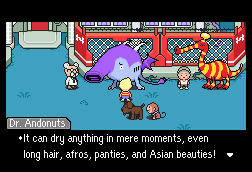 From the beginning, Dr. Andonuts and Mr. Saturn were teased in the EarthBound 64 previews. I don't think any of us were really surprised when they turned up in MOTHER 3. In one sense, they seem like throwbacks made for their own sake: neither Andonuts nor the Saturns refer to events from EarthBound or explain how they ended up on the Nowhere Islands (the Mr. Saturns might have even been there to begin with), and Itoi surely could have come up with another self-interested scientist or village of quirky demihumans. But as the unofficial mascot of the MOTHER series, Mr. Saturn pretty much had to return, and Dr. Andonut's appearance makes sense, though it isn't explained—of course Porky would think to kidnap and coerce the scientist whose work was instrumental in the defeat of Giygas. (I guess it does beg the question as to why he didn't nab Apple Kid as well, but we might be reading too much into things.)
From the beginning, Dr. Andonuts and Mr. Saturn were teased in the EarthBound 64 previews. I don't think any of us were really surprised when they turned up in MOTHER 3. In one sense, they seem like throwbacks made for their own sake: neither Andonuts nor the Saturns refer to events from EarthBound or explain how they ended up on the Nowhere Islands (the Mr. Saturns might have even been there to begin with), and Itoi surely could have come up with another self-interested scientist or village of quirky demihumans. But as the unofficial mascot of the MOTHER series, Mr. Saturn pretty much had to return, and Dr. Andonut's appearance makes sense, though it isn't explained—of course Porky would think to kidnap and coerce the scientist whose work was instrumental in the defeat of Giygas. (I guess it does beg the question as to why he didn't nab Apple Kid as well, but we might be reading too much into things.)
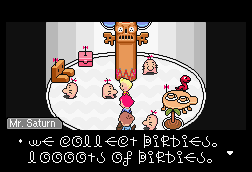 Once again, they fulfill auxilliary roles in the hero's adventure: Dr. Andonuts provides special chimeras to help Lucas reach the second Needle, and a Mr. Saturn polishes the Courage Badge and returns it to Lucas as the Franklin Badge. But in their most important function within MOTHER 3's plot, they mimic their prior roles in EarthBound. When we last saw them, Dr. Andonuts and the Mr. Saturns invent the Phase Distorter, allowing Ness and friends save the world by traveling into the past and confronting Giygas. In MOTHER 3, Dr. Andonuts and Mr. Saturn are compelled by Porky to create the Absolutely Safe Capsule, the ultimate panic room, allowing Lucas and friends to save the world by forcing Porky to retreat into it. (It's funny how "absolute safety" and "absolute imprisonment" basically mean the same thing.)
Once again, they fulfill auxilliary roles in the hero's adventure: Dr. Andonuts provides special chimeras to help Lucas reach the second Needle, and a Mr. Saturn polishes the Courage Badge and returns it to Lucas as the Franklin Badge. But in their most important function within MOTHER 3's plot, they mimic their prior roles in EarthBound. When we last saw them, Dr. Andonuts and the Mr. Saturns invent the Phase Distorter, allowing Ness and friends save the world by traveling into the past and confronting Giygas. In MOTHER 3, Dr. Andonuts and Mr. Saturn are compelled by Porky to create the Absolutely Safe Capsule, the ultimate panic room, allowing Lucas and friends to save the world by forcing Porky to retreat into it. (It's funny how "absolute safety" and "absolute imprisonment" basically mean the same thing.)
(As I type this it finally occurs to me that Dr. Andonuts is first met hiding in a garbage can, just like Loid's father in MOTHER. Two throwbacks for the price of one!)
CHIMERAS
Before meddling with Tazmily's villagers on a face-to-face level (via Fassad), Porky has his Pigmask soldiers initiate the Fascinating Chimera Project: the systematic conversation of Tazmily's run-of-the-mill fauna into belligerent cyborgs and hybrid mutants. And thus we meet one of the largest contingents of baddies Lucas and friends face throughout their adventure.
None of this seems to be integral or even connected to Porky's designs for Tazmily. He just thinks it would be cool. It's the germ logic of the solipsistic engineer, and the essence of the Fascinating Chimera Project: disruptive technology for its own sake. It represents science without conscience run completely amok, and it's an apt metaphor (one of many, really) for an era in which all technological progress is automatically presumed to be beneficial, regardless of its actual ramifications for human life in the long term.
THE PIGMASK ARMY
The iconic Starmen, the sleek and menacing alien soldiers of Giygas's army in both previous games, have stepped aside in MOTHER 3 and are replaced by a bunch of fat bastards in porcine stormtrooper outfits. From stars to swine.
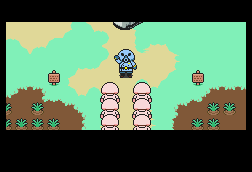 The Starmen were elusive foes, usually only found at their outposts and strongholds in the dark corners of the world. The Pigmask incursion begins as a covert operation, but by Chapter 4, they've more or less brought the Nowhere Islands under marial law. They're everywhere. We don't get to see the transition, so it remains unknown how the people of Tazmily are made to consent to their presence. The Happy Boxes' mollifying effect on the populace is obviously a contributing factor. And perhaps the villagers, seeing all the aggressive and strange new creatures running wild outside the village, and suffering from a plague of unnatural lightning storms, turned to the Pigmasks for protection—protection from the very dangers the Pigmasks brought to the island.
The Starmen were elusive foes, usually only found at their outposts and strongholds in the dark corners of the world. The Pigmask incursion begins as a covert operation, but by Chapter 4, they've more or less brought the Nowhere Islands under marial law. They're everywhere. We don't get to see the transition, so it remains unknown how the people of Tazmily are made to consent to their presence. The Happy Boxes' mollifying effect on the populace is obviously a contributing factor. And perhaps the villagers, seeing all the aggressive and strange new creatures running wild outside the village, and suffering from a plague of unnatural lightning storms, turned to the Pigmasks for protection—protection from the very dangers the Pigmasks brought to the island.
How very true to life.
FASSAD
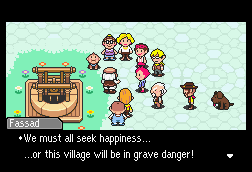 Finally, a MOTHER game finds a persistent antagonist. For most of MOTHER and EarthBound, Giygas's forces lurk in the shadows, unseen except for when the occasional Starman Junior, Mani Mani Statue, or Master Belch puts in an appearance. But in MOTHER 3, the Pigmasks' second-in-4command can be found standing in broad daylight in the center of Tazmily, exposed but frustratingly unassailable. (It's probably understood that Lucas knows it would be suicide picking a fight with Fassad out in the open: even if he was capable of physically threatening Fassad, he'd have an entire legion of Pigmasks dogpiling him in an instant, and the villagers would much sooner turn on him than on their beloved prophet.)
Finally, a MOTHER game finds a persistent antagonist. For most of MOTHER and EarthBound, Giygas's forces lurk in the shadows, unseen except for when the occasional Starman Junior, Mani Mani Statue, or Master Belch puts in an appearance. But in MOTHER 3, the Pigmasks' second-in-4command can be found standing in broad daylight in the center of Tazmily, exposed but frustratingly unassailable. (It's probably understood that Lucas knows it would be suicide picking a fight with Fassad out in the open: even if he was capable of physically threatening Fassad, he'd have an entire legion of Pigmasks dogpiling him in an instant, and the villagers would much sooner turn on him than on their beloved prophet.)
Fassad appears in Tazmily's town square two days after Hinawa's death, acting equally like Harold Hill and a Christian missionary. He promises peaces and happiness to those who listen to his message, and his message is "you need more material possessions and better material possessions." Three years later, most of Tazmily has been inducted into his cult of consumerism. They hang on to his every word, and trust him completely. Nobody in town except for Lucas and Wess have seen him for the sadistic machinator he truly is.
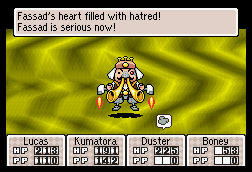 In a way, Fassad is the MOTHER 3 version of the Mani Mani Statue: not only does he serve as an agent of corruption and cause recurring headaches for the heroes, he's also surrounded by more question marks than almost anything else in the game. What was his reason for siding with Porky? Why did he betray the other Magypsies? How would he have felt about having his Needle pulled? Why would he go along with a plan that ends with him disappearing and everything in the world getting killed? Should we imagine that his choice to be rebuilt with trumpets protruding from his face are a sublimation of his Magypsie eccentricities? Why is he in disguise to begin with? What made him decide to be all male and no female? What was he like as Locria? Why don't any of the other Magypsies talk about him? If he's an immortal Magypsie, why does he seem to die after fighting and losing to Lucas and friends in Chapter 8?
In a way, Fassad is the MOTHER 3 version of the Mani Mani Statue: not only does he serve as an agent of corruption and cause recurring headaches for the heroes, he's also surrounded by more question marks than almost anything else in the game. What was his reason for siding with Porky? Why did he betray the other Magypsies? How would he have felt about having his Needle pulled? Why would he go along with a plan that ends with him disappearing and everything in the world getting killed? Should we imagine that his choice to be rebuilt with trumpets protruding from his face are a sublimation of his Magypsie eccentricities? Why is he in disguise to begin with? What made him decide to be all male and no female? What was he like as Locria? Why don't any of the other Magypsies talk about him? If he's an immortal Magypsie, why does he seem to die after fighting and losing to Lucas and friends in Chapter 8?
True to the style of the MOTHER series, none of these mysteries will ever be resolved. And again, sometimes it's more fun to wonder than to know.
At any rate, Fassad might also earn the distinction of being the toughest boss in the MOTHER series. Like most moustache-twirlers, he prefers to let his lackeys do his dirty work for him, but when he's made to exert himself, he means business.
THE MASKED MAN
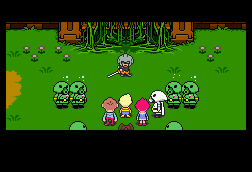 One of the highest-ranking figures in the Pigmask Army is a diminuitive, jackbooted fellow who wears a helmet that obscures his eyes and makes him look like a rebel pilot in a Star Wars flick. Like Lucas, he can use PK [Your Favorite Thing] and pull the Seven Needles. He is so similar in appearance to Lucas that his Pigmask subordinates are occasionally prone to mistaking Lucas for him. When he and Lucas meet face to face, Lucas gets a seriously weird feeling.
One of the highest-ranking figures in the Pigmask Army is a diminuitive, jackbooted fellow who wears a helmet that obscures his eyes and makes him look like a rebel pilot in a Star Wars flick. Like Lucas, he can use PK [Your Favorite Thing] and pull the Seven Needles. He is so similar in appearance to Lucas that his Pigmask subordinates are occasionally prone to mistaking Lucas for him. When he and Lucas meet face to face, Lucas gets a seriously weird feeling.
Rule #23 ("The Melfice Rule") of the Grand List of Console Role-Playing Game Cliches holds that if the male hero has an older sibling, the sibling will also be male and will turn out to be one of the major villains. So I don't think we're supposed to be that shocked when Flint tells us near the climax of Chapter 8 that the Masked Man is actually Claus. Maybe we're supposed to keep on waiting and waiting for the truth to come out, hoping that we're wrong, that there's some other explanation.
We'll talk more about the Masked Man a bit later.
TANETANE ISLAND
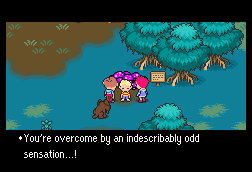 Some recreational users of psychoactive drugs are very quick and very eager to claim artists and designers as kindred spirits. More times than I'd like to admit, as a twentysomething student I'd spend whole afternoons sitting around with friends, all of us baked as yammonsters, affirming and agreeing that every single musician who came on the playlist was, like, definitely totally high. It's not that different where video games are concerned. Mario becomes super by eating shrooms, yo. And the game is a bunch of crazy stuff happening in this freaky place called the mushroom kingdom. Miyomoto be trippin'. He knows what up. Shrooms were legal in Japan in the 1980s, yanno? Etc., etc.
Some recreational users of psychoactive drugs are very quick and very eager to claim artists and designers as kindred spirits. More times than I'd like to admit, as a twentysomething student I'd spend whole afternoons sitting around with friends, all of us baked as yammonsters, affirming and agreeing that every single musician who came on the playlist was, like, definitely totally high. It's not that different where video games are concerned. Mario becomes super by eating shrooms, yo. And the game is a bunch of crazy stuff happening in this freaky place called the mushroom kingdom. Miyomoto be trippin'. He knows what up. Shrooms were legal in Japan in the 1980s, yanno? Etc., etc.
Where Starmen and psychedelia overlap, there's occasionally some discussion about EarthBound's trippy content and the possibility that maybe Itoi and/or some of the APE folks had once (or often) experimented with hallucinogens. If the "visual drug" battle backgrounds and the freaky far-out Moonside experience weren't inspired by drugs, then it can only mean that some people are capable of being imaginative without mind altering substances, and we all know that's a lot of fiddle faddle.
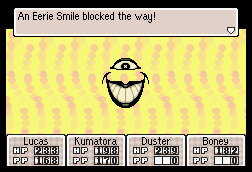 There's a sequence in MOTHER 3 that's a kind of spiritual sequel to Moonside. Things get really weird for a few minutes. You remember how it goes in EarthBound: Ness and Jeff unwittingly step into an manic, mixed-up version of Fourside created by the Mani Mani Statue. Once they find and smash the statue, the illusions it creates in their minds dissipate, and everything is back to norbal.
There's a sequence in MOTHER 3 that's a kind of spiritual sequel to Moonside. Things get really weird for a few minutes. You remember how it goes in EarthBound: Ness and Jeff unwittingly step into an manic, mixed-up version of Fourside created by the Mani Mani Statue. Once they find and smash the statue, the illusions it creates in their minds dissipate, and everything is back to norbal.
Things play out a bit differently in MOTHER 3. After getting thrown about on the sea and nearly drowning, Lucas and friends wash up on the shore of Tanetane Island. Weakened as they are, trying to swim back home and pressing on into the jungle are both suicidal propositions. They've lost all of their food, and neither Lucas nor Kumatora has the strength to use recovery PSI. Fortunately, the group discovers what appears to be a pile of edible mushrooms right there in the clearning next to the beach.
You see where this is going. And this might be another reason why Nintendo of America won't be planning to release MOTHER 3 around these parts in this lifetime: hallucinatory sequences caused by illusion-generating machines are one thing. Hallucinatory sequences caused by the actual ingestion of hallucinogens is another. Somebody has to think of the children.
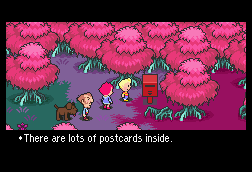 Visually, the Tanetane trip is rather understated, a lot less hyperactive and bizarre than the visit to Moonside. The verdure of the jungle takes on a lurid fuschia hue; certain familiar objects seem to assume different forms, and the local hostile chimeras appear on the field screen as visions of familar people (Claus, Flint, Wess, Alec, and so on) who say baffling, terrible things before dissolving into Eerie Stares that have to be fought or fled from. Strange mailboxes pop up at every corner, and what's inside reads like Christmas cards from Giygas.
Visually, the Tanetane trip is rather understated, a lot less hyperactive and bizarre than the visit to Moonside. The verdure of the jungle takes on a lurid fuschia hue; certain familiar objects seem to assume different forms, and the local hostile chimeras appear on the field screen as visions of familar people (Claus, Flint, Wess, Alec, and so on) who say baffling, terrible things before dissolving into Eerie Stares that have to be fought or fled from. Strange mailboxes pop up at every corner, and what's inside reads like Christmas cards from Giygas.
(Odd coincidence: in the Japanese MOTHER 2, a Moonside resident tells Ness and Jeff that they're mailboxes. And here we find a hallucination of a jungle full of mailboxes.)
Actually, this is all a fairly accurate rendition of a bad psilocybin trip. Moonside is more like an acid trip: LSD makes the world seem hyperactive and deconstructed and absurd. Psilocybin works harder on the emotions. When mushrooms turn on you, it's as though everything you were ever afraid of about yourself becomes irrefutibly, overwhelmingly true—you're a failure to yourself, all of your friends have disliked you all along, you're without any redemptive qualities and utterly alone in the universe, which is a well shaft that goes up forever and you're at the bottom and it's getting deeper and deeper and you keep sinking down and down and down and*
 Well, you get the idea. The Tanetane Island sequence isn't quite so dramatic, but the pith of it is that Lucas and friends are absolutely faced, and everything they come across in the jungle takes the form of a sneering personal demon. MOTHER 3 is more concerned with the characters than their journey, and so a hallucinatory excursion like this one—where their heroes are beset by wraiths of their insecurities and fears—is more germane than a mere reiteration of Fear and Loathing in Fourside.
Well, you get the idea. The Tanetane Island sequence isn't quite so dramatic, but the pith of it is that Lucas and friends are absolutely faced, and everything they come across in the jungle takes the form of a sneering personal demon. MOTHER 3 is more concerned with the characters than their journey, and so a hallucinatory excursion like this one—where their heroes are beset by wraiths of their insecurities and fears—is more germane than a mere reiteration of Fear and Loathing in Fourside.
*The bad trip in question took a happy turn when my then-girlfriend appeared and encouraged me to have a look at the stripey socks she was wearing. They were really quite delightfully fascinating. And then everything was just dandy, and soon I understood correctly that the universe was made of love.
NEW PORK CITY
Around the beginning of the deluxe-sized Chapter 7, Tazmily's burgeoned population begins to diminish as more and more of its residents pack their things and relocate to "the big city." Each time Lucas and friends revisit town as they crisscoss the island in search of the Seven Needles, fewer and fewer people remain until the village is almost completely empty. Once the sixth Needle is pulled, Lucas is approached by a mysterious chaffeur in a flying limousine who extends an invitation on behalf of Porky to come and live in New Pork City. "Where Master Porky is concerned," says the chaffeur, "there is no 'no.'"
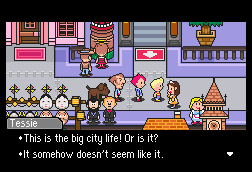 The ride to the city anticipates the city itself. As you look around through the limo's impossibly roomy interior and examine the billards tables, champagne towers, and dance stages, you find that it's all completely unusable. Everything is fake. And then you arrive in New Pork City itself, and discover that the capitol of the Pigmask empire isn't really a city at all: it's an amusement park disguised as a city, built according to the whims of a self-aggrandizing dictator with the brain of a developmentally stunted thirteen-year-old. It looks a lot like a life-sized version of a town you might have built out of Legos when you were six or seven—laying down a few streets and some basic buildings, and then decorating them with every available piece until virtually every possible space has been filled, attaining a model city in the fashion of some kind of toybox roccoco.
The ride to the city anticipates the city itself. As you look around through the limo's impossibly roomy interior and examine the billards tables, champagne towers, and dance stages, you find that it's all completely unusable. Everything is fake. And then you arrive in New Pork City itself, and discover that the capitol of the Pigmask empire isn't really a city at all: it's an amusement park disguised as a city, built according to the whims of a self-aggrandizing dictator with the brain of a developmentally stunted thirteen-year-old. It looks a lot like a life-sized version of a town you might have built out of Legos when you were six or seven—laying down a few streets and some basic buildings, and then decorating them with every available piece until virtually every possible space has been filled, attaining a model city in the fashion of some kind of toybox roccoco.
As you wander around the city streets, you'll notice that a lot of the buildings are actually wooden fronts. It reminds me of "Fascades," a piece by Sandinista poet Ernesto Cardenal. An excerpt:
We're going through the streets of a neighborhood in New York,
small shops, a restaurant, Dry Cleaning,
apartment houses, three-, four-stories high,
made of red brick, concrete, grey brick,
then we pass through a hamlet in the Alps,
cobblestone streets in a Mexican village,
then a river with a medieval mill,
a dusty street in a town in the West,
with its saloons, a window with broken glass,
on a hill an 11th-century castle,
and once again apartment houses, a bank, liquor stores
in any city in the United States,
but if you knock on anything it sounds hollow,
everything is plasterwork,
they're only the outside walls, there's nothing in back.
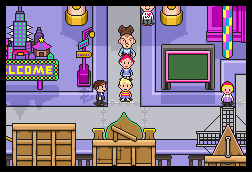 By the looks of things, even the amusement park rides are as fake and useless as the luxuries in the flying limousine. Even some of the Tazmilites who were excited about their village's shift into the fast lane are skeptical of New Pork City.
By the looks of things, even the amusement park rides are as fake and useless as the luxuries in the flying limousine. Even some of the Tazmilites who were excited about their village's shift into the fast lane are skeptical of New Pork City.
It's been over two decades since I've been to Disney World, but if my memories are at all to be trusted, it's like a real-world version (perhaps the inspiration) of New Pork: garish, infantile, and suffocatingly ersatz. Anyone who would enjoy spending a lot of time in places like these would have to be either dimwitted or brainwashed.
Maybe it's not totally fair to say that about people who enjoy taking a trip to the "magic kingdom" every now and then; but many of the people in New Pork are, in fact, fatuous dolts who go on and on and on about nothing ("Compared to, like, people long ago, don't you think we drink, like, way more water? Like, people in the old days didn't drink this much water, y'know? My old man, he, like, drinks waaaaay less water than me. When I, like, think about that, I, like, sorta feel like people are a lost cause, you know?! Like, if something happens, I, like, HAVE to have my water! Are we sea monsters? Of course we're not! We ARE, like, human, though! But we drink water.") or have otherwise spent some time immersed in a greenish solution that turns them into people who love New Pork City and worship its king.
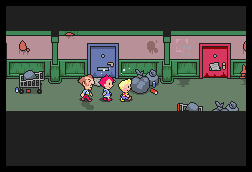 After a few minutes of exploration, you might notice something missing: places for people to live. MOTHER's Ellay and EarthBound's Fourside were filled with multi-story buildings that couldn't be entered, but were understood to be places occupied by the cities' residents. New Pork City has carnival rides, a movie theater, an arcade, a restaurant, and more crazy chintzy crap than could fill the walls of an entire region of TGI Friday's locations, but there doesn't seem to be anywhere for people to come home to after a long day of puttering around and spending their money. And then you finally wander into a filthy tenement building with trash-filled hallways, and the festering truth behind New Pork City's glitzy fascade becomes clear. Old Tazmily might have been quiet and low-tech, but the happy simplicity of its community life was positively opulent compared to the indignity and spiritual impoverishment of New Pork.
After a few minutes of exploration, you might notice something missing: places for people to live. MOTHER's Ellay and EarthBound's Fourside were filled with multi-story buildings that couldn't be entered, but were understood to be places occupied by the cities' residents. New Pork City has carnival rides, a movie theater, an arcade, a restaurant, and more crazy chintzy crap than could fill the walls of an entire region of TGI Friday's locations, but there doesn't seem to be anywhere for people to come home to after a long day of puttering around and spending their money. And then you finally wander into a filthy tenement building with trash-filled hallways, and the festering truth behind New Pork City's glitzy fascade becomes clear. Old Tazmily might have been quiet and low-tech, but the happy simplicity of its community life was positively opulent compared to the indignity and spiritual impoverishment of New Pork.
PORKY MINCH
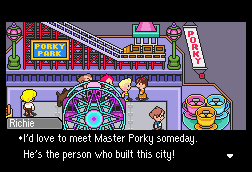 (Note: Tomato's MOTHER 3 translation reverses the "Pokey" of EarthBound's official English translation to the "Porky" of the original Japanese. In EarthBound, the tweak made some sense: English-speaking fans were likely to associate the name with a famous cartoon pig with a good attitude and a bad stutter, and the change didn't have much of an impact elsewhere. But in MOTHER 3, "Porky" makes much more sense for a dictator at the head of an army of men dressed like pigs, and "New Pork City" appears too many times in the field maps to be renamed "New Poke City" or whatever in the text.)
(Note: Tomato's MOTHER 3 translation reverses the "Pokey" of EarthBound's official English translation to the "Porky" of the original Japanese. In EarthBound, the tweak made some sense: English-speaking fans were likely to associate the name with a famous cartoon pig with a good attitude and a bad stutter, and the change didn't have much of an impact elsewhere. But in MOTHER 3, "Porky" makes much more sense for a dictator at the head of an army of men dressed like pigs, and "New Pork City" appears too many times in the field maps to be renamed "New Poke City" or whatever in the text.)
My excitement for EarthBound 64 was (mostly) unqualified, but it really took off when I noticed the title had been appended to EarthBound 64: The Fall of the Pig King. Who was the Pig King?! Was it Pokey? It had to be Pokey, right?!
The answer, of course, was yes.
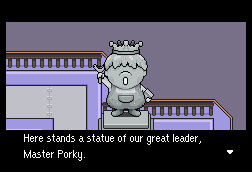 I wish I hadn't spoiled the reveal for myself before playing the game, because it's so remarkably well executed. Early on, you begin hearing people referring to a "King P" at the head of the Pigmask Army. If that in itself isn't a dead giveaway, the familiar contents of the playroom in Thunder Tower leave litle room for doubt as to the identity of King P. By the time people start tossing around the names "King Porky" or "Master Porky," you're not the least surprised to see all the images of EarthBound's l'enfant terrible all over New Pork City. When you reach the top floor of the Empire Porky Building, you can't but expect to meet Porky Minch as he appeared at the end of EarthBound as he slung one last taunt at Ness before making his escape into the timestream.
I wish I hadn't spoiled the reveal for myself before playing the game, because it's so remarkably well executed. Early on, you begin hearing people referring to a "King P" at the head of the Pigmask Army. If that in itself isn't a dead giveaway, the familiar contents of the playroom in Thunder Tower leave litle room for doubt as to the identity of King P. By the time people start tossing around the names "King Porky" or "Master Porky," you're not the least surprised to see all the images of EarthBound's l'enfant terrible all over New Pork City. When you reach the top floor of the Empire Porky Building, you can't but expect to meet Porky Minch as he appeared at the end of EarthBound as he slung one last taunt at Ness before making his escape into the timestream.
By his own admission, Porky is still the same little kid at heart—but he's a monstrous freak otherwise. Thousands of years of time travel have changed him. He hasn't aged normally: though his body is still small, pudgy, and childlike, his hair is gray, his skin is cadaverously pale, and he coughs and wheezes like the centuries-old geezer he is. (Were he depicted in a more detailed art style, I imagine he would look a lot like Masaru from the movie Akira.)
(A nice touch: before Porky appears in person, the "chatter" sound accompanying his dialogue as he speaks over the building's PA system carries the same pitch of the other young boys in the game. When he begins speaking to Lucas and friends directly, the tone of his chatter is much deeper.)
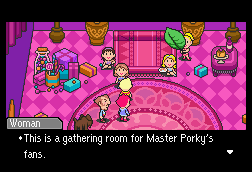 Time travel hass changed much more than the way Porky ages: it has also made him immortal. Porky will never, ever die. He is invincible—but so infirm that he can't even move about on his own.
Time travel hass changed much more than the way Porky ages: it has also made him immortal. Porky will never, ever die. He is invincible—but so infirm that he can't even move about on his own.
At the climax of MOTHER, Giygas appears as the vengeful tube baby at the head of the alien invasion force; in EarthBound, a creature called Giygas appears as the embodiment of evil at the center of a hive of a similar-looking alien force. The two Giygases might be the same creature; but for all we know, they could also be two unrelated beings with the same name (like the two versions of Kagato in Tenchi Muyo! and Tenchi Universe). If MOTHER's Giygas and EarthBound's Giygas are the same entity, the chain of events leading to his transformation from one to the other are completely open to speculation.
In EarthBound, Giygas enlists a cowardly, spiteful boy named Porky Minch as one of his champions. In MOTHER 3, the Nowhere Islands and every living thing on them are oppressed by a wretched, deranged time traveler named Porky Minch. There's too much evidence to doubt that the Porky in MOTHER 3 is an immensely aged version of the Porky who worked to foil Ness in EarthBound. But we're not given much specific information about what he's been up to during the one to ten thousand (even he isn't really sure) years since he began skimming through time. We can make a few inferences: perhaps he salvaged enough of Giygas's alien technology to keep him armed and in business at his next destination, and then spent some hundreds of years hopping from era to era, forcibly conscripting more followers in each time period until he either left of his own volition or got chased out. We know for certain that for some reason, he's been locked out of every time period except for the one in which the young twins Lucas and Claus are enjoying their boyhood years with their family in Tazmily Village, and so he has no alternative but to establish his new reign on the Nowhere Islands.
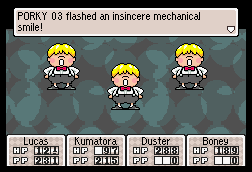 We can't be sure exactly how long he's been on the islands prior to the start of the game: some circumstantial evidence suggests he's been there for at least a little while before Hinawa wonders at the strange flying object passing over in the sky. (It's unlikely the underground tunnels Fassad and Salsa use to get from the desert to Tazmily were constructed in just one day.) It's also unclear how long he has been in cahoots with the rogue Magypsy Locria or how the two made each other's acquaintance; we're not even sure what he's been up to for most of the game until he drops down from the ceiling on the top floor of the Empire Porky Buildng. (If the vines that have grown over his capsule are any indication, he's been sitting up there by himself for a very, very long time.)
We can't be sure exactly how long he's been on the islands prior to the start of the game: some circumstantial evidence suggests he's been there for at least a little while before Hinawa wonders at the strange flying object passing over in the sky. (It's unlikely the underground tunnels Fassad and Salsa use to get from the desert to Tazmily were constructed in just one day.) It's also unclear how long he has been in cahoots with the rogue Magypsy Locria or how the two made each other's acquaintance; we're not even sure what he's been up to for most of the game until he drops down from the ceiling on the top floor of the Empire Porky Buildng. (If the vines that have grown over his capsule are any indication, he's been sitting up there by himself for a very, very long time.)
When he arrives on the islands, Porky doesn't seem to have much of a master scheme to enact. Like a thirteen-year-old boy with too much time on his hands, he is guided by caprice. His first order of business is to get his minions to start transforming the local critters into vicious cyborgs and volatile chimeras, for no real reason. Then he sets in motion the modernization of Tazmily and places more people on the islands, but his motivations are anyone's guess. He sends his forces to recover the Hummingbird Egg—the only surviving piece of technology from the ruined world beyond the islands—but it's never stated why he wants it or what he intends to do with it. In fact he seems to lose all interest in it once he dispatches the Masked Man to pull out the Seven Needles and awaken the Dark Dragon to destroy all terrestrial life for good. (Why does he wait more than three years to begin this plan? Did it take him and Fassad that long to realize that their PSI-wielding monster was capable of pulling the Needles?)
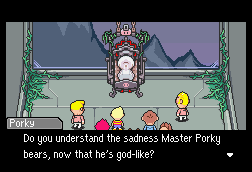 But Porky does have a reason for wanting to revive the Dark Dragon. Because of his immortality, he'll be the only person to survive if a person with a dark heart (or with no heart) were to pull out the Needles. He and the Dragon would be the only living things on Earth for the rest of time—and everyone who didn't like him will be dead, and nobody who might not like him will ever be born. If Porky has anything in common with his old boss Giygas, it's the extent to which the monstrous and the pitiful are conjoined in his character.
But Porky does have a reason for wanting to revive the Dark Dragon. Because of his immortality, he'll be the only person to survive if a person with a dark heart (or with no heart) were to pull out the Needles. He and the Dragon would be the only living things on Earth for the rest of time—and everyone who didn't like him will be dead, and nobody who might not like him will ever be born. If Porky has anything in common with his old boss Giygas, it's the extent to which the monstrous and the pitiful are conjoined in his character.
Giygas is never mentioned in MOTHER 3. Porky either brazenly lies about his alliance with the alien mastermind, or has otherwise convinced himself that he was actually associated with Ness, the hero who defeated Giygas, the cool, popular next-door neighbor he once admired and despised. (Come to think of it, there may be some points of contact between Giygas's feelings toward Maria in MOTHER and Porky's feelings towards Ness in EarthBound. I wish I'd thought of that before.)
Porky infuses MOTHER 3 with a revisionist's nostalgia, casting himself as the chum and ally of the boy who saved the world instead of his bitterest foe. Judging by the way he enshrines a yoyo that once belonged to Ness, maybe Porky really does believe he was on the other side of the fight in EarthBound—after all, he does brag about his exploits when he "followed the visionary, selfish desires of a great hero." (Maybe in his delusions, he's conflated Ness and Giygas?)
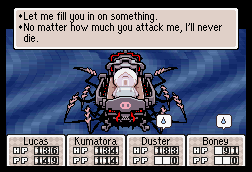 Porky is all about childhood nostalgia. Like the self-declared "nineties kid" who's now in his thirties (the same sort of person who writes interminable chronicles of the video games he played decades ago), Porky just can't bring himself to move on from the games and toys of his boyhood days. And like the adult who explicitly and habitually refers to cartoons and movies and video games as "my childhood," Porky cleaves to memories of experiences that aren't really his own. The past he enshrines in the "museum" on the penultimate floor of the Empire Porky Building belongs to Ness, not to himself.
Porky is all about childhood nostalgia. Like the self-declared "nineties kid" who's now in his thirties (the same sort of person who writes interminable chronicles of the video games he played decades ago), Porky just can't bring himself to move on from the games and toys of his boyhood days. And like the adult who explicitly and habitually refers to cartoons and movies and video games as "my childhood," Porky cleaves to memories of experiences that aren't really his own. The past he enshrines in the "museum" on the penultimate floor of the Empire Porky Building belongs to Ness, not to himself.
Porky is the supreme otaku; the #1 EarthBound superfan. He wants you to know that he's more of an EarthBound fan than you'll ever be. Oh, so you've spotted all the hidden throwbacks to your favorite video game of 1994–5? You even recognize that the pair of black and white specks at the end of the Hall of the Past boat ride are the two lovelorn sesame seeds from the Dusty Dunes Desert? That's cute, says Porky. I own the sesame seeds. I can feel your envy, peasant. Porky thinks of you like he thinks of Ness. He hates your guts to the same extent that he demands validation from you.
 More ambiguities: I have a hard time believing that the nostalgia bomb preceding Porky's introduction is purely a giftwrapped treat from Itoi to longtime MOTHER fans. It seems more likely to be a friendly warning not to keep your old toys too close for too long, and not to cling too tenaciously to a bygone childhood. This seems most clear in the room between the boat ride and the stairway to Porky's grotto, where we find—OH MY GOD, FOR SOME WEIRD REASON, THERE'S AN PENCIL-SHAPED IRON STATUE JUST SITTING IN THE MIDDLE OF THIS ROOM!!! (You see how I cleverly referenced the line from EarthBound describing the pencil statue in my own description of the pencil statue?!) And what's this?! WELL PUT A GUN IN MY MOUTH AND CALL ME ERNEST, THERE'S A PENCIL ERASER SITTING IN THE BOX RIGHT NEXT TO THE PENCIL STATUE! HOLD ON I TOTALLY KNOW WHAT'S COMING LET ME SAVESTATE THIS SO I CAN DO IT AGAIN AT MY LEISURE. HAH HAH HAH I KNEW IT WHEN I USE THE PENCIL ERASER ON THE STATUE, THE STATUE VANISHES FOR SOME WEIRD REASON! JUST LIKE IN EARTHBOUND!!! GOD OH MY GOD MY CHILDHOOD MY CHILDHOOD
More ambiguities: I have a hard time believing that the nostalgia bomb preceding Porky's introduction is purely a giftwrapped treat from Itoi to longtime MOTHER fans. It seems more likely to be a friendly warning not to keep your old toys too close for too long, and not to cling too tenaciously to a bygone childhood. This seems most clear in the room between the boat ride and the stairway to Porky's grotto, where we find—OH MY GOD, FOR SOME WEIRD REASON, THERE'S AN PENCIL-SHAPED IRON STATUE JUST SITTING IN THE MIDDLE OF THIS ROOM!!! (You see how I cleverly referenced the line from EarthBound describing the pencil statue in my own description of the pencil statue?!) And what's this?! WELL PUT A GUN IN MY MOUTH AND CALL ME ERNEST, THERE'S A PENCIL ERASER SITTING IN THE BOX RIGHT NEXT TO THE PENCIL STATUE! HOLD ON I TOTALLY KNOW WHAT'S COMING LET ME SAVESTATE THIS SO I CAN DO IT AGAIN AT MY LEISURE. HAH HAH HAH I KNEW IT WHEN I USE THE PENCIL ERASER ON THE STATUE, THE STATUE VANISHES FOR SOME WEIRD REASON! JUST LIKE IN EARTHBOUND!!! GOD OH MY GOD MY CHILDHOOD MY CHILDHOOD
(The fact that the pencil statue is covered with rust from top to bottom is not without meaning.)
 Porky replaces memories of his childhood adventures with memories of Ness's childhood adventures. When he has his chaffeur "test" Lucas in order to adequately belittle him before letting him advance further, he uses the robotic Master Mini-Porky as a stand-in for himself. He considers the chimerized Claus as extension of his own will. He doesn't want anyone around him who isn't thinking thoughts he put in their heads. He speaks to Lucas (and probably even to his subordinates) from a distance, out of sight, and with a false voice that masks his age and his speech-inhibiting respirtory problems. He takes pains to ensure that he's seen only via simulacrum, and every image of himself presents him as the dapper, pudgy little boy he (kind of) used to be. He's only ambulatory with the aid of his machines. He makes it his goal to be alone forever in the world with a dragon whose heart mirrors his own; his ultimate fate, being bounded in a nutshell and counting himself a king of infinite space for all time, appears to suit him just fine.
Porky replaces memories of his childhood adventures with memories of Ness's childhood adventures. When he has his chaffeur "test" Lucas in order to adequately belittle him before letting him advance further, he uses the robotic Master Mini-Porky as a stand-in for himself. He considers the chimerized Claus as extension of his own will. He doesn't want anyone around him who isn't thinking thoughts he put in their heads. He speaks to Lucas (and probably even to his subordinates) from a distance, out of sight, and with a false voice that masks his age and his speech-inhibiting respirtory problems. He takes pains to ensure that he's seen only via simulacrum, and every image of himself presents him as the dapper, pudgy little boy he (kind of) used to be. He's only ambulatory with the aid of his machines. He makes it his goal to be alone forever in the world with a dragon whose heart mirrors his own; his ultimate fate, being bounded in a nutshell and counting himself a king of infinite space for all time, appears to suit him just fine.
So Porky is also the ultimate hikkikomori: incapable of unmediated experience, unwilling to face a world containing any uncomfortable unknown variables or possibilities. He prefers to play games.
Jeez. We could keep going on and on. Porky is quite a character. "Truly a poem in himself," Itoi remarks to Nintendo Dream Magzine.
 That's the benign way of putting it. Elsewhere in the interview, Itoi goes off on a bit of a tangent about the appearance of MOTHER 3's logo:
That's the benign way of putting it. Elsewhere in the interview, Itoi goes off on a bit of a tangent about the appearance of MOTHER 3's logo:
When things that don't match at all are attached to one another, it's mentally unsettling. I've only written one novel, and in the opening, I wrote about a hearse. A hearse has a casket of both metal and wood, but when you try and think about how and where they connect to one another, it makes you feel a little weird. It's also interesting how it's meant to carry bodies. Modern things can all be seen in that same way. And you can't question whether we can negate all of these things. In this room, too, for example, there is a wooden table... but this is a reinforced concrete building. Forcibly coordinating incompatible things and matching them....
...I feel like these are all things of modern times—these feelings of uneasiness and discomfort. But I still understand that they make up the world I'm in. That logo is a symbol of that. And Porky is a symbol of humankind.
And you thought Giygas was disturbing.
What is he trying to do to this village?
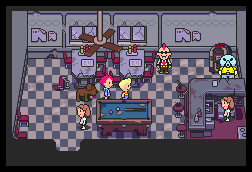 Itoi's remarks about "these things of modern times" bring us to the most biting part of MOTHER 3, the very incisors of the experience. By virtue of selection, the modern world is celebrated in both MOTHER and EarthBound. Itoi could have chosen any setting imaginable to host his games, and he chose this one, the Planet Earth of our modern age, and painted it as an altogether fun and colorful place to live and explore; a place where everything would be just dandy if it weren't for the alien adversary marshalling its forces in the dark margins. MOTHER 3 turns this on its on its head: the more modern, the closer to our world the Nowhere Islands become, the worse off they are.
Itoi's remarks about "these things of modern times" bring us to the most biting part of MOTHER 3, the very incisors of the experience. By virtue of selection, the modern world is celebrated in both MOTHER and EarthBound. Itoi could have chosen any setting imaginable to host his games, and he chose this one, the Planet Earth of our modern age, and painted it as an altogether fun and colorful place to live and explore; a place where everything would be just dandy if it weren't for the alien adversary marshalling its forces in the dark margins. MOTHER 3 turns this on its on its head: the more modern, the closer to our world the Nowhere Islands become, the worse off they are.
Even though it's a Gameboy game with cute cartoon characters and an improbable story that begins with a couple of kids playing with the dinosaurs living in their grandpa's backyard, MOTHER 3 delivers a fairly scathing indictment of modernity. You already knew that, though: the narrative is so uniformly sodden with misgivings about urbanism, technology, and consumerism that only the most inattentive player can't help but notice them dripping from her Gameboy onto her lap. As obvious and as blunt as they are, I think it would be fun to spend a few minutes unpacking them.
"NATURALLY..."
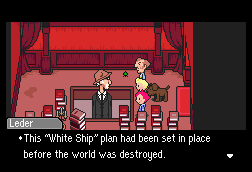 Towards the end of the game, Itoi (probably unwittingly) borrows a few pages from the Chrono Cross playbook. First: just before the heroes embark on a showdown with their arch nemesis, a ream of crucial backstory is delivered to them via text dump provided by the long-missing Leder. Second: Leder reveals that the human inhabitants of the Nowhere Islands are all people from a distant (perhaps not too distant) future who had the memories of their previous lives erased. Third: the substance of Leder's story about the White Ship is that even though the heroes of the prior game succeeded in saving the world from one cataclysm, it amounted only to a temporary reprieve. Armegeddon comes crashing down anyway, just at a later date. In Chrono Cross, the reason for this is, uh, a little complicated. The apocalypse in MOTHER 3 is much more humdrum: people did it, says Leder:
Towards the end of the game, Itoi (probably unwittingly) borrows a few pages from the Chrono Cross playbook. First: just before the heroes embark on a showdown with their arch nemesis, a ream of crucial backstory is delivered to them via text dump provided by the long-missing Leder. Second: Leder reveals that the human inhabitants of the Nowhere Islands are all people from a distant (perhaps not too distant) future who had the memories of their previous lives erased. Third: the substance of Leder's story about the White Ship is that even though the heroes of the prior game succeeded in saving the world from one cataclysm, it amounted only to a temporary reprieve. Armegeddon comes crashing down anyway, just at a later date. In Chrono Cross, the reason for this is, uh, a little complicated. The apocalypse in MOTHER 3 is much more humdrum: people did it, says Leder:
At some point, the world wound up destroyed. Naturally, it was humans who destroyed it. In the back of their minds, everyone had an inkling it would happen at some point. And then it really did happen.
Leder's appending the explanation with the line I've bolded is tremendously significant: it draws attention to a remarkable feature of the post-1945 perception of the world. It has become almost given that human civilization as we know it, and the biosphere in its current configuration, are probably both fucked, and we can lay the blame for both at the feet of humanity en masse.
The things that Ness went to such trouble to save—Eageland and its towns, with their bicycle shops, department stores, theaters, cars, museums, libraries, arcades, schools, and beachside resorts—are all organs of a culture whose malignancies not only led to its own destruction, but to the near-extinction of the human race and the eradication of nearly all life on Planet Earth. The mode by which humanity destroys the world was (or will be, as our case may prove) an outgrowth of human culture, no matter how charming the surface effects of that culture (or how good and kind its people might be).
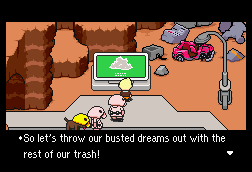 Leder doesn't get into specifics about the end of the world, but we can make some guesses. The world of MOTHER has always been a distorted image of our own, and our own world still has enough nuclear weapons (one estimate puts the number at over 16,000) to incinerate every major city and enshroud the planet in a nuclear winter. Every investigation into every corner of the ecology retrns with a report that things are unbelievably bad and getting worse. The concentration of greenhouse gases in the atmosphere is on the rise, and the rate of increase is accelerating. The oceans are rising and increasing in acidity, and each of them now has a vast cogeries of plastic and styrofoam detritus at its heart. The rainforests are shrinking and the deserts are growing. The icecaps are melting, the coral reefs are diminishing, biodiversity is plummeting at every meridian, and it doesn't look like things will be turning around any time soon.
Leder doesn't get into specifics about the end of the world, but we can make some guesses. The world of MOTHER has always been a distorted image of our own, and our own world still has enough nuclear weapons (one estimate puts the number at over 16,000) to incinerate every major city and enshroud the planet in a nuclear winter. Every investigation into every corner of the ecology retrns with a report that things are unbelievably bad and getting worse. The concentration of greenhouse gases in the atmosphere is on the rise, and the rate of increase is accelerating. The oceans are rising and increasing in acidity, and each of them now has a vast cogeries of plastic and styrofoam detritus at its heart. The rainforests are shrinking and the deserts are growing. The icecaps are melting, the coral reefs are diminishing, biodiversity is plummeting at every meridian, and it doesn't look like things will be turning around any time soon.
What's scarier than all of this is the fact that we don't seem to be scared at all. We're aware of all of this, and yet we go blithely about our business as though none of it was real. And when one crucial pillar of the world finally buckles and the whole thing falls to pieces, we already know we'll have nobody but ourselves to blame. And like Leder says, it's not like we won't have seen it coming. (Disjoining this background fact from MOTHER 3 is to ignore the game's context.)
"THE TOWN, THE LIVES, AND EVEN THE HEARTS OF THE PEOPLE..."
 So we know that a small band of refugees from the old world set sail in a White Ship and found the one habitable place left on the planet: the Nowhere Islands. There they had a choice to make. We can postulate that nothing was preventing them from salvaging what they could from the wreckage and bringing it with them. The existence of the Hummingbird Egg suggests that the people of the White Ship still had some extant technology at their command. They could have lived as the survivors of the old world, carrying the torch of their lost civilization. Instead they tried to erase their past and begin anew, innocent of civilization's sins. Knowing what they did about the old world, they chose to reject it.
So we know that a small band of refugees from the old world set sail in a White Ship and found the one habitable place left on the planet: the Nowhere Islands. There they had a choice to make. We can postulate that nothing was preventing them from salvaging what they could from the wreckage and bringing it with them. The existence of the Hummingbird Egg suggests that the people of the White Ship still had some extant technology at their command. They could have lived as the survivors of the old world, carrying the torch of their lost civilization. Instead they tried to erase their past and begin anew, innocent of civilization's sins. Knowing what they did about the old world, they chose to reject it.
High noon of the anthropocene age began with the concerted forces of industrialism and capitalism sweeping across the globe, so the people of Tazmily set their clock back to a time before both. The new world has no scientists or engineers. No machines. No mass production. No merchantilsm. No institutionalized greed. No smokestacks or chemical runoff. No immediate paths towards reviving any of these things.
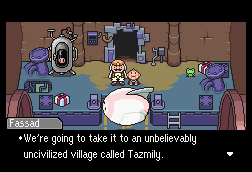 Maybe it would have worked indefinitely. Maybe Tazmily would have achieved a comfortable homeostasis and remained more or less in its original form for many generations to come. (To wish for paradise is, in effect, to wish for progress to stand still. It is a state of equilibrium in which no improvements are necessary or even wished for.) But we'll never know. The experiment failed. The new Eden invited a new serpent, and the results were more or less the same as its antediluvean counterpart.
Maybe it would have worked indefinitely. Maybe Tazmily would have achieved a comfortable homeostasis and remained more or less in its original form for many generations to come. (To wish for paradise is, in effect, to wish for progress to stand still. It is a state of equilibrium in which no improvements are necessary or even wished for.) But we'll never know. The experiment failed. The new Eden invited a new serpent, and the results were more or less the same as its antediluvean counterpart.
There are two ways we can look at Porky's motivations for bringing "civilization" to Tazmily. We can proceed with the Paradise Lost analogy and say that he's driven by purely by spite, as Satan was. And there's some evidence for this in what he says in his address to Lucas and friends during their first proper introduction:
You resorted to blanking your memories to create a new world where humanity's past failures would never be repeated... How stupid can you be?! No matter how much you change the rules, no matter how much you refuse to admit defeat, in the end, the creatures known as "people" will always sign their own death warrant by acting out of stupidity and evil.
He's right, of course. And he's right because he made damn sure it would happen. Maybe he was just speeding up the process—but we'll never know.
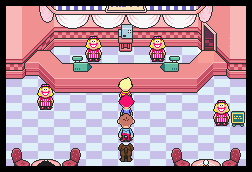 Or we might surmise that he's compelled by his demented sense of nostalgia: the image in which he reshapes the new world closely matches the Eagleland of his childhood. Of course, being a time traveler, he can't but know that his world eventually followed the rails of progress right off a cliff. Porky's winsome brains are so scrambled and he's such a wheezing blob of contradictions that it's useless trying to sketch a coherent profile of his intentions: either he wants to cheat the last people on Earth of their chance to make things work, or he wants to bestow his broken world upon them out of a self-serving, toxic beneficience. Maybe a little of both.
Or we might surmise that he's compelled by his demented sense of nostalgia: the image in which he reshapes the new world closely matches the Eagleland of his childhood. Of course, being a time traveler, he can't but know that his world eventually followed the rails of progress right off a cliff. Porky's winsome brains are so scrambled and he's such a wheezing blob of contradictions that it's useless trying to sketch a coherent profile of his intentions: either he wants to cheat the last people on Earth of their chance to make things work, or he wants to bestow his broken world upon them out of a self-serving, toxic beneficience. Maybe a little of both.
So Porky gives the people modernity. What does Tazmily lose in the bargain?
The most obvious answer would be that he bilks them of the happiness of a simple, innocent existence, but that's not quite it. But Tazmily is denuded of something precious. What is that thing?
A late nineteenth/early twentieth-century German sociologist named Ferdinand Tönnies wrote a book called
Gemeinschaft und Gesellschaft ("Community and Civil Society"), which examines the changes to the nature of social networks as a society transforms from a pre-industrial, pre-capitalist Gemeinschaft (Community) culture to one defined by Gesellschaft (Civil Society) as industry, urbanism, and capitalism rewrite the ways in which people relate to each other. If you can get your hands on a copy, I'm sure you will find it an edifying read, but the gist of his treatise on Gemeinschaft (Community) goes something like this: in the "natural" state of things, people living in groups are essentially one big (happy) family. The cell of community life is the family and the characteristic relationships between its members, and the modus of community relations is essentially that of an extended household, united by the land, work, and common purpose or spirit they all share. Let's let Tönnies explain:
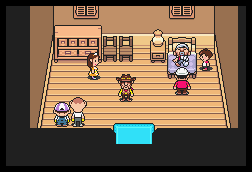 [W]e can now establish the fundamental laws of all community: 1. Relatives and spouses love each other or easily get used to one another. They often think of each other and like to converse together. The same is true of neighbors and other friends as well. 2. There is mutual understanding betwen those who love each other. 3. Those who love and understand each other stay together and organize their joint existence.
[W]e can now establish the fundamental laws of all community: 1. Relatives and spouses love each other or easily get used to one another. They often think of each other and like to converse together. The same is true of neighbors and other friends as well. 2. There is mutual understanding betwen those who love each other. 3. Those who love and understand each other stay together and organize their joint existence.
The aggregate of determinate will which governs a community, and which is as natural as language itself and contains a multitude of understanding regulated by its norms, I shall call a concord or family spirit (the term concordia implies a heartfelt sense of integration and unanimity). Mutual understanding and concord are one and the same thing: namely the will of the community in its most basic forms. Understanding operates in the relations between individuals, concord is the strength and character of the whole.
Mutual understanding or sympathy is the simplest expression for the inner reality of all genuine co-existence, where people live and work together.
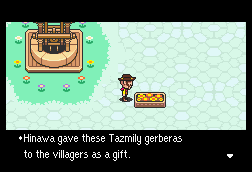 This is only a fragment, of course, and Tönnies elsewhere points out some of the ways in which familial relations can go sour, authority can be abused, etc. There might be cause to accuse Tönnies of romanticizing medievalism and tribalism, but this is another conversation entirely. For the moment, let's assume there's at least a kernel of truth to what he says: that when things are in their right proportion in a Gemeinschaft society, the situation is one in which people live and work together for the good of the aggregate, sustained by interdependent relationships of love, friendship, and responsibility.
This is only a fragment, of course, and Tönnies elsewhere points out some of the ways in which familial relations can go sour, authority can be abused, etc. There might be cause to accuse Tönnies of romanticizing medievalism and tribalism, but this is another conversation entirely. For the moment, let's assume there's at least a kernel of truth to what he says: that when things are in their right proportion in a Gemeinschaft society, the situation is one in which people live and work together for the good of the aggregate, sustained by interdependent relationships of love, friendship, and responsibility.
Social concord allows an order and harmony, contained in its very nature and inner core, to develop as the form and content of community life, so that every member does what is right for him, what he must or is obliged to do; each of them enjoys what is his own, and what is right and proper for him to enjoy.
When we're first introduced to Tazmily, we find the villagers enjoying this kind of community spirit. The fact that everyone in town has a name and addresses Flint by his own is indicative of their fellowship—nobody is a stranger to anyone else—and the village-wide efforts to save Lighter and Fuel from the forest fire and then to search for Hinawa and the twins goes further in showing the extent to which the community is bound together by obligation and affection We also get a sense of the mutual understanding between thevillagers by observing how quickly Abbot and Ollie forgive Flint for lashing out at them. You wouldn't give someone a pass for socking you in the face or smacking you in the kneecap with a log unless it were somebody to whom you were especially close—and the villagers are exceptionally close. They're a family.
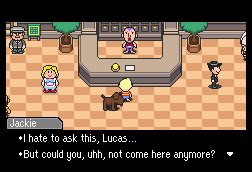 We can compare what we see here with the state of affairs in Tazmily three years later. We find the town full of people who have descriptors instead of names: "Man," "Girl," "Guy," "Lady," and so forth. with the creep of urbanism into village life, the people are no longer nearly so closely connected as they once were. (As per Louis Wirth, "urbanism" doesn't necessarily require a densely populated city.) When people in town suffer misfortune or indignity—like when Reggie's teepee gets blasted by lightning, or when Wess is dragged off like a stray animal by the Pigmasks, or when some nameless punker dude is thrown in jail for doing nothing but picking a doorknob up off the ground—nobody gives a damn. And we find that some of the villagers are still holding a grudge against Duster for allegedly stealing Butch's money. Three years ago, they were willing to give Flint the benefit of the doubt; Duster enjoys no such kindness. We also see Jackie, whose once-humble Yado Inn is now the prosperous Yado Hotel, asking Lucas to stop coming around. It's nothing personal; but Lucas is widely recognized as an outcast, and having him on the premises is bad for business.
We can compare what we see here with the state of affairs in Tazmily three years later. We find the town full of people who have descriptors instead of names: "Man," "Girl," "Guy," "Lady," and so forth. with the creep of urbanism into village life, the people are no longer nearly so closely connected as they once were. (As per Louis Wirth, "urbanism" doesn't necessarily require a densely populated city.) When people in town suffer misfortune or indignity—like when Reggie's teepee gets blasted by lightning, or when Wess is dragged off like a stray animal by the Pigmasks, or when some nameless punker dude is thrown in jail for doing nothing but picking a doorknob up off the ground—nobody gives a damn. And we find that some of the villagers are still holding a grudge against Duster for allegedly stealing Butch's money. Three years ago, they were willing to give Flint the benefit of the doubt; Duster enjoys no such kindness. We also see Jackie, whose once-humble Yado Inn is now the prosperous Yado Hotel, asking Lucas to stop coming around. It's nothing personal; but Lucas is widely recognized as an outcast, and having him on the premises is bad for business.
Concerns for such matters of business over personal relationships is the mark of a society guided by the pole star of Gesellschaft (Civil Society), the antithesis of Gemeinschaft. Tönnies explains:
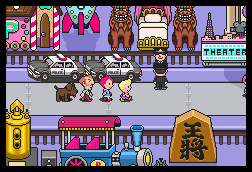 The theory of Gesellschaft takes as its starting point a group of people who, as in Gemeinschaft, live peacefully alongside one another, but in this case without being essentially united—indeed, on the contrary, they are essentially detached. In Gemeinschaft they stay together despite everything that separates them; in Gesellschaft they remain separate in spite of everything that unites them. As a result, there are no activities taking place which are derived from an a priori and pre-determined unity and which therefore express the will and spirit of this unity through any individual who performs them.
The theory of Gesellschaft takes as its starting point a group of people who, as in Gemeinschaft, live peacefully alongside one another, but in this case without being essentially united—indeed, on the contrary, they are essentially detached. In Gemeinschaft they stay together despite everything that separates them; in Gesellschaft they remain separate in spite of everything that unites them. As a result, there are no activities taking place which are derived from an a priori and pre-determined unity and which therefore express the will and spirit of this unity through any individual who performs them.
Gesellschaft thus forms a single aggregate, and must be understood as a mass or multitude or natural and artificial individuals. Their wills and spheres of influence interact with each other in manifold different ways, yet they remain independent of one another and lacking in deep intimacy.
Much of Tönnies's explication of Gesellschaft is heavily inflected with Marxism, and we do have to be careful if we're going to talk about capitalism in MOTHER 3. None of the turbines of the capitalist engine (stock markets, corporations, bourgeoise pigs, etc.) are actually present. (Well, except for the pigs.) But the social consequences of the capitalist order—namely the brittle social relationships of people living in Gesellschaft—are on full display.
"THINGS ARE DIFFERENT NOW. DON'T FORGET TO BRING DP."
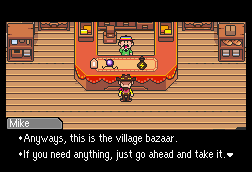 At the beginning of MOTHER 3, Tazmily really is less of what we today would recognize as a "town" and more of what we might call a "commune." None of the villagers have any concept of money, and they willingly pool their resources for the common good. The center of commerce in Tazmily is Thomas's Bazaar, where people come to drop off the goods they've produced and take what they need from what the other villagers have offered up for community use. Nobody has to ask permission or put down an exchange. (Tönnies: Community life means mutual possession and enjoyment, and possession and enjoyment of goods held in common.)
At the beginning of MOTHER 3, Tazmily really is less of what we today would recognize as a "town" and more of what we might call a "commune." None of the villagers have any concept of money, and they willingly pool their resources for the common good. The center of commerce in Tazmily is Thomas's Bazaar, where people come to drop off the goods they've produced and take what they need from what the other villagers have offered up for community use. Nobody has to ask permission or put down an exchange. (Tönnies: Community life means mutual possession and enjoyment, and possession and enjoyment of goods held in common.)
Elsewhere, we see villagers just handing away their work and its products over to their peers. For instance, Issac the woodsman leaves out a box of antidotes for anyone passing through the Sunshine Forest (and risking encounters with poisonous bitey snakes). Nippolyte and Bateau receive no payment for digging graves or providing carrier pigeons. During the search for Hinawa and the twins, Duster is summoned because his unique skills are required to scale the cliff and reach the Oriander Plateau. He's absolutely in a position to strike a deal, to say "well, what's in it for me?", but the thought never even occurs to him. He and everyone else are just doing their jobs, as a member of a functioning household carries out tasks required of them, understanding that the people they live with are looking out for them by carrying out their own allotted work.
 There's only one place we see even a barter system in play, and that's at Caroline's house. If you bring Caroline nuts (found lying in the fields and by the woods), she'll bake them into cookies and bread loaves for you. It's not even an equal exchange: Caroline gets nothing out of it but the opportunity to do the work she enjoys and the satisfaction of seeing it benefit her neighbors, while Fint and Duster walk away with useful items. And everyone seems happy with arrangement.
There's only one place we see even a barter system in play, and that's at Caroline's house. If you bring Caroline nuts (found lying in the fields and by the woods), she'll bake them into cookies and bread loaves for you. It's not even an equal exchange: Caroline gets nothing out of it but the opportunity to do the work she enjoys and the satisfaction of seeing it benefit her neighbors, while Fint and Duster walk away with useful items. And everyone seems happy with arrangement.
Then Porky sends in Fassad.
Tönnies's comments about "the merchant" neatly touch upon Fassad and the position he carves out for himself in Tazmily:
[The merchant] is the first reflective and free human being to appear in the normal development of social life. He stands isolated as far as possible from all constraining connections, duties or prejudices. ("A merchant, it has been said very properly, is not necessarily the citizen of any country": Adam Smith, The Wealth of Nations, bk. III, ch. 4; a passage which might be compared with the previously cited statement by the same author, that exchange makes a merchant of every man.) He is free from the ties of community life, and the freer he is, the better it is for him.
 Fassad is someone who is able to move through the community and exert a tremendous force upon its weights and levers without being personally connected or beholden to any of its members. He's the first person in the memory of the village ever to do so. And with the arrival of Fassad, the fabric begins to unravel: community degenerates from union into association, to use more of Tönnies's phrasing.
Fassad is someone who is able to move through the community and exert a tremendous force upon its weights and levers without being personally connected or beholden to any of its members. He's the first person in the memory of the village ever to do so. And with the arrival of Fassad, the fabric begins to unravel: community degenerates from union into association, to use more of Tönnies's phrasing.
It's fitting that Fassad's first act in Tazmily is to exchange Butch a bag of money for a few of his pigs—convincing Butch to trade him something of intrinsic and concrete use-value for something of imaginary exchange-value. And thus his "era of money" begins.
Before Fassad's arrival, the Tazmilites' relations are wholly direct and personal. The introduction of money into village life ushered an abstract interlocutor into the affairs of its members. When relationships between human beings are arbitrated by an artificial third party, the relationships cease to be entirely authentic; the impersonality of the medium of exchange bleeds into them.
 Think of it this way. Imagine you're hosting a potluck for some of your friends and neighbors. Everyone comes over and brings a dish to share with the other guests; everyone sits down and enjoys a meal together. It's simple, cordial, and satisfying. Now imagine a potluck dinner where everyone who brings a dish won't let anyone else help themselves to a serving unless they fork over a few bucks first. It wouldn't be nearly as warm or enjoyable an evening, to say the least. Whatever quality is present in the first scenario and absent from the second is what's lost after Tazmily adopts Fassad's ideas. That's Gesellschaft.
Think of it this way. Imagine you're hosting a potluck for some of your friends and neighbors. Everyone comes over and brings a dish to share with the other guests; everyone sits down and enjoys a meal together. It's simple, cordial, and satisfying. Now imagine a potluck dinner where everyone who brings a dish won't let anyone else help themselves to a serving unless they fork over a few bucks first. It wouldn't be nearly as warm or enjoyable an evening, to say the least. Whatever quality is present in the first scenario and absent from the second is what's lost after Tazmily adopts Fassad's ideas. That's Gesellschaft.
In the old Tazmily, Flint is Caroline's neighbor. In the new Tazmily, Lucas is Caroline's customer. The difference between these two kinds of relationships isn't just a matter of closeness, but of duration. One is indefinite, holding as long as the community exists and both parties belong to it. The other begins and ends with the transaction.
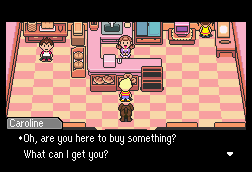 Nowhere is the dissolution of Tazmily's communal ties expressed more clearly than in the dismal prison where the village seniors are forced to relocate. Nobody wants to be responsible for them anymore; most people (except for Nan and Linda, apparently) probably don't see any reason why they should be. Put them somewhere where nobody has look at them or think about them, so we can enjoy all of our Happy new products without interruption.
Nowhere is the dissolution of Tazmily's communal ties expressed more clearly than in the dismal prison where the village seniors are forced to relocate. Nobody wants to be responsible for them anymore; most people (except for Nan and Linda, apparently) probably don't see any reason why they should be. Put them somewhere where nobody has look at them or think about them, so we can enjoy all of our Happy new products without interruption.
"JUST SHUT UP AND WORK, WILL YA?"
We've seen that everybody in the old Tazmily works in the village. Flint is a shepherd, Bronson is a blacksmith, Bateau is a pigeon keeper, Bud and Lou are lumberjacks, and so on. Their work is done for the direct benefit of themselves and the community. All of the wood from which the houses are constructed has probably been handled by Bud and Lou. Anything made out of iron is likely Bronson's handiwork. The pigeon Hinawa sends off with her letter to Flint must roost at Bateau's house. We can even guess that most of the clothes on the villagers' backs came from wool sheared by Flint and spun by Hinawa.
Three years later, we see that Tazmily's economics are much more like those of a twentieth-century suburb. Nobody works the land anymore, and fewer people are employed in or around the village. Many have begun working in a distant factory to which they commute by train. It must seem as ordinary to use as anything, but our familiarity doesn't mean we can overlook the alienation inherent in the new state of affairs. Most of Tazmily's people are now (like most of us) estranged from their labor, its products, and increasingly to each other.
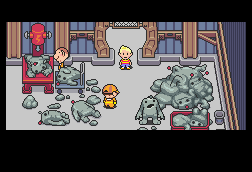 Let's take Bronson as an example. He was once employed in the village as a blacksmith. He performed a trade he excelled at, and to all appearances took pride and pleasure in. (Notice how the first thing he says about the drago fang in Hinawa's heart is how he could probably make it into a cool weapon.) He performed a service for the members of the community. He was an invaluable part of the village, directly providing something to his neighbors and receiving benefits directly from them in return.
Let's take Bronson as an example. He was once employed in the village as a blacksmith. He performed a trade he excelled at, and to all appearances took pride and pleasure in. (Notice how the first thing he says about the drago fang in Hinawa's heart is how he could probably make it into a cool weapon.) He performed a service for the members of the community. He was an invaluable part of the village, directly providing something to his neighbors and receiving benefits directly from them in return.
Three years later, Bronson rides the train to the factory every day. The factory seems to have no purpose but to produce Clayman slaves for the Pigmask Army. Given Lucas's experience, we can guess the workday is long and tedious. If we Bronson's words to Jackie as they the train as being representative of his daily life, he gets up early, puts in an exhausting shift, and then goes home and vegetates by himself. (He's bought some new sophisticated blacksmithing gear, but we never see him making anything for anyone anymore.)
People coming off the train from a factory shift wear identical orange uniforms: their unique roles in the life of the village have been supplanted by the interchangeable anonymity of wage laborers. Nobody really seems to prefer factory work to their previous occupations, either. Everyone complains about how long and exhausting their days are, and in another breath, they'll bitch at Lucas about not working at the factory himself.
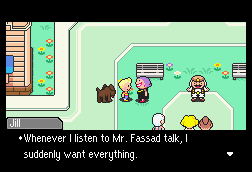 The factory workers hate their jobs, but they like the perks: money in their pockets and tickets to Club Titiboo. MOTHER 3 makes fairly clear that this is a lousy exchange. The villagers' work is now of a much more degrading quality, it doesn't offer the satisfaction of making a direct contribution to the well-being of one's neighbors, and the main beneficiary of the whole operation is a remote entity that has no reason to care about the welfare of Tazmily or the lives of inhabitants. But hey, they get their paychecks, and there's so much cool new stuff to spend them on! So it works out, right...?
The factory workers hate their jobs, but they like the perks: money in their pockets and tickets to Club Titiboo. MOTHER 3 makes fairly clear that this is a lousy exchange. The villagers' work is now of a much more degrading quality, it doesn't offer the satisfaction of making a direct contribution to the well-being of one's neighbors, and the main beneficiary of the whole operation is a remote entity that has no reason to care about the welfare of Tazmily or the lives of inhabitants. But hey, they get their paychecks, and there's so much cool new stuff to spend them on! So it works out, right...?
"FASCINATING BIG CITY ITEMS"
Fassad's era of money is conjoined with a consumer culture that must be immediately familar to all of us living in the twenty-first century. He inculcates in the villagers the belief that ownership equates to happiness. Own more things, be more happy.
Contemporary consumerism depends on the fostering of artificial desires in the hearts and minds of the populace. There's a Calvin and Hobbes strip that encapsulates it perfectly: Hey Mom, I saw a bunch of products on TV that I didn't know existed, but I desperately need! This is Fassad's modus operandi from the moment he appears in the village square to deliver his first sermon.
 There are millions of manmade things that are inessential to survival or even to a satisfying existence; the task of the merchant is to persuade as many people as possible (ideally everybody) that these things are essential. "Look at this thing I have. Now that you know it exists, and now that you see other people you know in possession of it, you will be neither nor happy nor complete until you possess it yourself." The singular goal of the game is to keep it going ad infinitum: creating new unncessary things, convincing people that they are necessary, and never allowing them to feel content with what they already have. (And the players are really good at it. A friend of mine who served in the Peace Corps in West Africa tells me stories about village fathers who felt the purchase of a secondhand iPhone took precedence over buying vaccinations and medicine for their children. Well done.)
There are millions of manmade things that are inessential to survival or even to a satisfying existence; the task of the merchant is to persuade as many people as possible (ideally everybody) that these things are essential. "Look at this thing I have. Now that you know it exists, and now that you see other people you know in possession of it, you will be neither nor happy nor complete until you possess it yourself." The singular goal of the game is to keep it going ad infinitum: creating new unncessary things, convincing people that they are necessary, and never allowing them to feel content with what they already have. (And the players are really good at it. A friend of mine who served in the Peace Corps in West Africa tells me stories about village fathers who felt the purchase of a secondhand iPhone took precedence over buying vaccinations and medicine for their children. Well done.)
The long-term satisfaction of belonging to and contributing to a community is superseded by the transient glee of acquisition—and of the exigencies of keeping up with the Joneses, and the smug pleasure of finding yourself ahead of them. Abbot demonstrates this nicely: look how happy he is that Lucas is coming to his house and seeing all the neat stuff he's amassed. "Oh, Lucas. Are you so jealous of my happiness that you've come to see it for yourself?" (It's a real petty thing for an adult to say to a pre-teen boy, don't you think?) Meanwhile, Abbey just goes mincing around the kitchen, talking about how happy she is with her purchase of a Happy Cooling Box and how much she's looking forward to buying a Happy Massage Chair. (Three years ago, Abbey grew trees and flowers, presumably to beautify the village she lives in. Not anymore.)
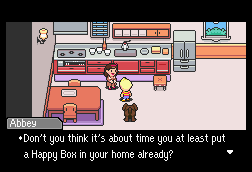 (Where are all these Happy Boxes, refrigerators, cars, and big city merchandise coming from, anyway? They're certainly not being manufactured in town, and it doesn't seem like any of the locals have anything to do with their production. In the old Tazmily, everything traded and used in the village represented the communal bonds of the villagers. Now that nobody in the village is involved in the work of production, their labor no longer binds them together as it once did. They are simultaneously alienated from their work and their neighbors, and the property they collect approaches them as objects with no past or provenance.)
(Where are all these Happy Boxes, refrigerators, cars, and big city merchandise coming from, anyway? They're certainly not being manufactured in town, and it doesn't seem like any of the locals have anything to do with their production. In the old Tazmily, everything traded and used in the village represented the communal bonds of the villagers. Now that nobody in the village is involved in the work of production, their labor no longer binds them together as it once did. They are simultaneously alienated from their work and their neighbors, and the property they collect approaches them as objects with no past or provenance.)
It takes only half an instant of introspection to see that in the endless lines of people queued up at the Apple Store to shell out hundreds of dollars for the newest iPhone tweak are dozens of Abbots and Abbeys, waiting for the newest thing they need in order to bring happiness to their life at last. For now. Until the next version.
In the twenty-first century, we are all conditioned to be Abbot and Abbey.
"HAPPINESS"
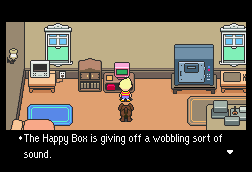 Abbot and Abbey are among the first villagers to enjoy owning a Happy Box. It isn't surprising that the first gadget Fassad introduces to Tazmily is the device that might have had the most profound and far-reaching influence upon global society in the second half of the twentieth century: television.
Abbot and Abbey are among the first villagers to enjoy owning a Happy Box. It isn't surprising that the first gadget Fassad introduces to Tazmily is the device that might have had the most profound and far-reaching influence upon global society in the second half of the twentieth century: television.
Okay. MOTHER fans who have done their homework will point out that Itoi himself has stated that the Happy Boxes aren't TV sets (and that they underwent several design changes to make them look more dissimilar to Lucifer's dream box). But there really isn't that much of a difference between them. Marshall McLuhan, the reluctant prophet of contemporary mass media, famously declared that the medium is the message: the content delivered by any medium is of secondary importance to the way in which people engage with it. So even if the Happy Box doesn't deliver moving pictures, sports games, or news reports—it seems to just glow and make funny noises—the people of Tazmily interact with it the same way we interact with our TVs: by sitting still and quietly staring at them for extended periods.
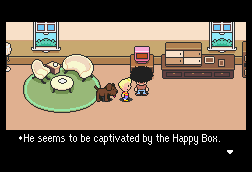 Watching the Happy Box becomes the villagers' preferred form of recreation. Like television, the Happy Box seems to be a powerful reinforcer. People just can't look away from them. If you visit the Yado Hotel, you'll find a girl by herself in one of the rooms, glued to the Happy Box and crying. "Grandpa and I are supposed to go to the beach after I change into my swimsuit," she explains, "but I can't take my eyes off this Happy Box."
Watching the Happy Box becomes the villagers' preferred form of recreation. Like television, the Happy Box seems to be a powerful reinforcer. People just can't look away from them. If you visit the Yado Hotel, you'll find a girl by herself in one of the rooms, glued to the Happy Box and crying. "Grandpa and I are supposed to go to the beach after I change into my swimsuit," she explains, "but I can't take my eyes off this Happy Box."
I'm pretty sure that elsewhere I've told the story about getting an NES for Christmas when I was four years old: about how that very day I pissed my pants because I couldn't pull myself away from Duck Hunt. Different media, same difference. People conditioned by such an environment are going to be much less interested in any of the other contents or people or events within that environment. (Turn on a TV in a room full of people and watch how quickly they lose interest in each other.)
To understand the purpose of the Happy Box in Porky's plans, we need only look to Mr. Bill Hicks for a few sage words on the role of its real-life conunterpart in real-life society. There are those for whom it's much better that people are less invested in the world than they might otherwise be.
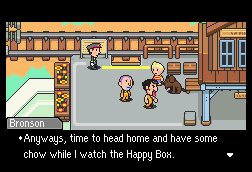 The Happy Box is a useful opiate employed by the Pigmasks to ensure the cooperation of Tazmily's villagers. It must be hard for any of the Tazmilites to worry for long about the vicious mutants running wild outside of town, entertain concerns about how the Pigmasks are suddenly running everything, or wonder about the propriety of locking away all the old people when they're habitually spending a few hours each day gazing at the Happy Box and tuning out everything else. Sound familiar?
The Happy Box is a useful opiate employed by the Pigmasks to ensure the cooperation of Tazmily's villagers. It must be hard for any of the Tazmilites to worry for long about the vicious mutants running wild outside of town, entertain concerns about how the Pigmasks are suddenly running everything, or wonder about the propriety of locking away all the old people when they're habitually spending a few hours each day gazing at the Happy Box and tuning out everything else. Sound familiar?
It would be dishonest of us to say the TV shows, clickhole websites, and (yes even) video games we immerse ourselves contribute nothing to our consenting to let the demons of the world run wild, provided they don't interfere with our screen time. When the status quo consists of routine injections of artificial bliss, you're probably not going to have much of an appetite to push against it. Let the lightning fall where it will. You have your happiness.
 We are all Abbot and Abbey, surrounding ourselves on every side by wobbling, flickering Happy Boxes. We've made the choice to care more about the stuff that we own (and the stuff we'd like to own) than our people or our planet, and we've shown ourselves more than eager to lock ourselves away and get our bliss on in private rather than make an effort to prevent the pigs from putting their shoulders to the wheel and their hooves to the gas. And somewhere along the way we seem to have agreed that this is the way it must be.
We are all Abbot and Abbey, surrounding ourselves on every side by wobbling, flickering Happy Boxes. We've made the choice to care more about the stuff that we own (and the stuff we'd like to own) than our people or our planet, and we've shown ourselves more than eager to lock ourselves away and get our bliss on in private rather than make an effort to prevent the pigs from putting their shoulders to the wheel and their hooves to the gas. And somewhere along the way we seem to have agreed that this is the way it must be.
Welcome to the world of MOTHER 3.
The Masked Man attacks!
The final battles in MOTHER 3 are atypical of console RPGs: as we've seen, they eschew the usual explosive rumble between good and evil where the heroes violently slay their malefactor in the name of Love and Peace. At the end of MOTHER, Ninten and friends force Giygas to retreat by singing him a lullaby. When Giygas returns in EarthBound as a universe-devouring cosmic terror, the heroes don't fight him, but call upon the hope and goodwill of their friends (and of the person holding the controller) to save the day. Giygas doesn't make a repeat appearance in MOTHER 3: instead, the big bad awaiting Lucas at the end of the road is none other than his brother Claus.
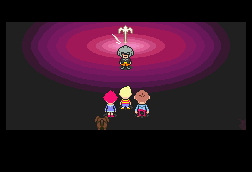 Far from being invested with the alien terror of either fight with Giygas, the final battle against Claus is a human affair through and through. The mood of dread and panic prevailing at the battle's onset gradually relents, softens, and gives way to the sorrowful joy of a redemption and reconciliation much too late in coming, but better late than never.
Far from being invested with the alien terror of either fight with Giygas, the final battle against Claus is a human affair through and through. The mood of dread and panic prevailing at the battle's onset gradually relents, softens, and gives way to the sorrowful joy of a redemption and reconciliation much too late in coming, but better late than never.
Like in EarthBound, the actual fighting is over with as soon as the heroes put away Porky by force. Lucas can't outfight Claus; he can't fight him, period. If you choose any offensive commands, Lucas will refuse to carry them out. Nor can he run away: the game won't let him, for one thing, and he knows he's the only thing stopping Claus from pulling the last Needle and ensuring that the Dark Dragon wipes out what's left of the world when it wakes up. And he has to face Claus without the help of his allies: everyone but Lucas enters the battle with 0 HP, and Claus immediately puts them back down if Lucas attempts to revive them.
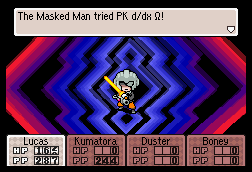 Unable to fight or flee, all Lucas can do is endure. What this means for the player is that the only possibly course of action is to have Lucas repeatedly heal himself as Claus repeatedly inflicts mortal damage on him with beams and PSI attacks, and use the Defend command to slow his HP rollers as they spin continuously downward. (Remember Final Fantasy IV? "To be a real Paladin...you must not fight now!")
Unable to fight or flee, all Lucas can do is endure. What this means for the player is that the only possibly course of action is to have Lucas repeatedly heal himself as Claus repeatedly inflicts mortal damage on him with beams and PSI attacks, and use the Defend command to slow his HP rollers as they spin continuously downward. (Remember Final Fantasy IV? "To be a real Paladin...you must not fight now!")
MOTHER 3 is about the dissolution of a family and a community. The beginning of the end for Tazmily was heralded by the shattering of Flint and Hinawa's family. And the beinning of the world's restortation is enacted with the reunion of that family.
Claus is trying to kill Lucas. Lucas can't do anything but stand there and take it. Flint tries to put himself between his sons (and gets blasted to his knees by an attack intended for Lucas), and Hinawa intervenes from The Other Side, admonishing Claus to remember who he is and stop fighting. It takes a long time for—much longer than the first-time player will be comfortable with as she watches Lucas's HP and PP continually depleting—for Claus's true self to overcome the artificial self Porky foisted upon him. The conflict within Claus—between Porky's monster and Hinawa's boy—is illustrated less vividly in the occasional line of narration ("The Masked Man is gazing at Lucas." "The Masked Man covered his ears.") than in the distortion and blurring of the battle background and the intrusion of the "MOTHER 3 Love Theme" tune into the minatory "Battle Against the Masked Man" track.
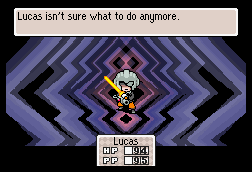 It's the music that holds the entire scene together. "Music is one of the most powerful tonal controllers that there is," Loren Bouchard has said. "You can turn someone's mood like you're turning a dial." He's spot on, and thats exactly how it is with every emotional sequence in MOTHER 3, particularly the final battle. It might be possible to write the whole thing off as maudlin hokum if Shogo Sakai's score didn't so insidiously commandeer your emotions, making it impossible to approach the scene with incredulity or callousness. (MOTHER 3's score, it should be said, is composed by Shogo Sakai, who deftly takes the baton from Keiichi Suzuki and Hirokazu Tanaka.)
It's the music that holds the entire scene together. "Music is one of the most powerful tonal controllers that there is," Loren Bouchard has said. "You can turn someone's mood like you're turning a dial." He's spot on, and thats exactly how it is with every emotional sequence in MOTHER 3, particularly the final battle. It might be possible to write the whole thing off as maudlin hokum if Shogo Sakai's score didn't so insidiously commandeer your emotions, making it impossible to approach the scene with incredulity or callousness. (MOTHER 3's score, it should be said, is composed by Shogo Sakai, who deftly takes the baton from Keiichi Suzuki and Hirokazu Tanaka.)
The most heartbreaking moment isn't at the conclusion, but during the flashback to the day of the twins' birth, where their ofscreen parents share a conversation over their cribs:
I bet they'll accomplish things together that they couldn't alone. I'm sure they'll argue a lot, too. And I can see them helping each other out when they need it....
Claus. Lucas. Make us proud.
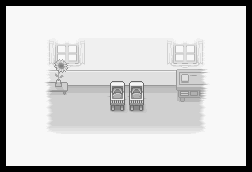 It's a crushing reminder how much irreparable damage Porky has caused, how much he has stolen from this family. He's denied the twins of their whole lives together as brothers. None of Hinawa's hopes for them will be fulfilled. And the worst part of it is that Porky has already gotten his comeuppance—there's nothing else you can do to make him pay for what he's done. Even if there was, what's been done is irreversible. Hinawa will never rejoin the living, and Claus is no longer entirely human—and at the instant of his reawakening, the last violent thrashing of Porky's moribund programming brings him to destroy himself.
It's a crushing reminder how much irreparable damage Porky has caused, how much he has stolen from this family. He's denied the twins of their whole lives together as brothers. None of Hinawa's hopes for them will be fulfilled. And the worst part of it is that Porky has already gotten his comeuppance—there's nothing else you can do to make him pay for what he's done. Even if there was, what's been done is irreversible. Hinawa will never rejoin the living, and Claus is no longer entirely human—and at the instant of his reawakening, the last violent thrashing of Porky's moribund programming brings him to destroy himself.
But Flint and Lucas are still able to share a final moment with Claus before he passes on to join Hinawa. The last moments of Claus's life elapse without any visuals: the screen is either whited or blacked out, and you have only the narration and Claus's dialogue to go by. A word must be said about Itoi's brilliant use of timing here: the words don't appear onscreen at once, and the rate at which they crawl across the screen can be slowed or momentarily stopped for dramatic effect:
Claus staggered toward Lucas.
Lucas
[pause]
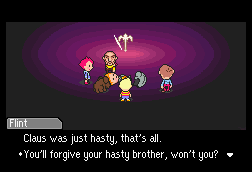 remembered Claus's smell.
remembered Claus's smell.
At last, as he holds his dead son in his arms, Flint starts acting like the father Lucas hasn't had for three years, urging Lucas to believe in himself and pull the Neelde. (Wait. How did Flint know about the Dark Dragon, anyway?)
Itoi has said that his original plan for MOTHER 3's ending was much more ambiguous that what eventually made it into the game. I have a hard time imagining that: as it is, the ending is a real tease, but somehow very satisfying in how it leaves you hungry. The Dark Dragon wakes up; we observe the cataclysmic destruction of the Nowhere Islands, and then the screen goes dark.
Is this the END?
Apparently not. Although you can't see anything, the characters of MOTHER 3 anonymously step forward to directly address you (the player) to let you know that somehow, miraculously, nobody was hurt and everything turned out okay. (We can only take their word for it.) And they thank you for your help, and then they have to go.
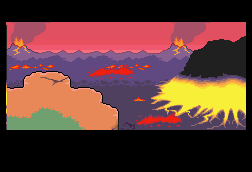 What's the world there like? It looks like things will work out here, but what about your world? Will it be alright?
What's the world there like? It looks like things will work out here, but what about your world? Will it be alright?
And that's the stinger. That's the admonition from the world of MOTHER 3 as it wishes you well and vanishes into the ether.
What about that doorknob? At the beginning of the game, Thomas accidentally breaks the knob off Flint's front door. For the next three years it gets rolled and passed and kicked around until finally turning up at the end of things.
After Lucas and Claus run off the screen after their last bow at the conclusion of the postgame curtain call, the doorknob makes its final appearance. So the last image we see after the cast has departed and before the production credits begin rolling is a little round doorknob by itself on the blank screen.
Even in a so game full of ambiguity at the caboose of a series so full of ambiguity, this really takes the undefined object that might be (but just as likely isn't) cake. What does the doorknob mean?
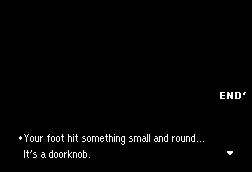 As usual, Itoi supplies the sensations while leaving players to supply their meaning.
As usual, Itoi supplies the sensations while leaving players to supply their meaning.
I've never been able to accept what might be the most obvious interpretation: "you can ALWAYS revists the world of MOTHER 3 whenever you want! Just pop the cartridge back into your Gameboy, start a new game file, and there you are!" If the doorknob merely represents your capability to start over again and follow the events of Tazmily's darkest hour to their inexorable conclusion, to watch Hinawa and Claus die and see the Nowhere Islands destroyed all over again, then it might as well represent a locked door, trapping you in the past and shutting you out of the brilliant new world Lucas and the Dragon brought to life.
I'd prefer to think of the doorknob as an invitation to imagine that world yourself. We can't hope to create a better, more beautiful Planet Earth unless we're able to envision what we wish to build.
I suppose that brings us to the end, too.
MOTHER 3 is an astonishing game from beginning to end. Though it's modest in its ambitions—it's yet another console-style RPG after all, and makes no effort to break that mold—it achieves a richness of character and such a wide and penetrating range of emotions few games could hope to match. I'd go so far as to call it the Great Gatsby of video games: exquisite in its construction, relatively small in volume but deceptively dense, and satisfying through and through. It's certainly the most human of any game I can recall playing, exuding nothing but compassion for the foibles, ridiculousness, and triumphs of its characters.
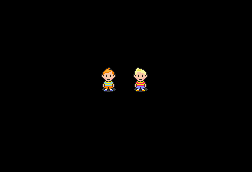 For all its darkness—and it is a very dark game—it sounds a note hope that for all of humanity's corruptibility, and despite its apparently irresistible inclination towards its most destructive and poisonous behaviors, there's an inextinguishable goodness that might just prevail in the end. There's kindness to be found even in the cruelest people, there's slivers of goodness and the possibility for redemption even in the most corrupt, and there's a chance for a better tomorrow even when things seem their most hopeless. Even the most jaded gamers who have seen hundreds of neat little optimistic happy endings can't but be moved by MOTHER 3's sincerity.
For all its darkness—and it is a very dark game—it sounds a note hope that for all of humanity's corruptibility, and despite its apparently irresistible inclination towards its most destructive and poisonous behaviors, there's an inextinguishable goodness that might just prevail in the end. There's kindness to be found even in the cruelest people, there's slivers of goodness and the possibility for redemption even in the most corrupt, and there's a chance for a better tomorrow even when things seem their most hopeless. Even the most jaded gamers who have seen hundreds of neat little optimistic happy endings can't but be moved by MOTHER 3's sincerity.
And amazingly, MOTHER 3 doesn't feel dated, not even for a moment. It's a game that could have easily come out on the Sega Saturn (or even as a minute-to-midnight SNES title) in 1997, and yet I could also imagine it hitting the market as an iOS game next week and still turning heads and winning hearts. In an industry where the cutting edge so quickly turns to obsolesence, a game—a JRPG, no less—that realizes a quantum of timelessness is no mean feat, especially when its brilliance is not owed to a redefinition or deconstruction of a genre, but purely to the virtuosity and earnestness it exudes. MOTHER 3 is the astonishing consummation of Shigesato Itoi's foray into RPGs, catapaulting what would have otherwise remained a couple of cult hits to the stature of videogame legend.
Thanks as always for tuning in. It might be a while before I do another video game writeup, but in the meantime you can see what I'm up by checking out my blog. I also have a new novel, All the Lonely People (alternate title: Love in the Time of Dial-up), which I hope you'll enjoy as well.
Until we meet again!
Next: ?




